speaking of the OS/2 2.0 lighthouse, thanks to google images, I just googled it..
It is Cape Neddick Light.
And..

speaking of the OS/2 2.0 lighthouse, thanks to google images, I just googled it..
It is Cape Neddick Light.
And..
I just read this great post on OS/2 Museum, and I was greatly intrigued.
While a kind person had sent me a copy of this rare pre-release version of OS/2, I never could install it because it crashed on my real hardware, nor would it install in any emulator I had access too.
Apparently the two problems for this version, like the 1.x series of OS/2 revolves around timing issues, and floppy drivers. Â While the limited availability seems to be more laid out like a 1.21 version it still 32-bit, so attempts to replace the floppy/country.sys from 1.21 or 1.3 just result in instant crashes.
Back when I ran OS/2 the big issue with 486 computers and booting was the L2 CPU cache. Â It would induce all kinds of timing problems with booting from floppy to install. Â And the number ONE fix for this was to disable L2 (and even L1) cache, and the install could proceed, then once you are booting from hard disk you could re-enable them.
The funny thing is that while OS/2 2.0 & 2.1 were so temperamental on so many clones, they install just fine in emulation.  So I had an idea…
What if I used the 2.0 GA to boot up the LA install program?
So I simply copied the following files from LA’s disk1 onto 2.0 GA’s disk1 ..
So then I simply booted off the GA install/disk1 then swapped in the LA disks as needed. Â Surprisingly it boots from the hard disk on Virtual PC 2007 without issue. Â It traps on Qemu.
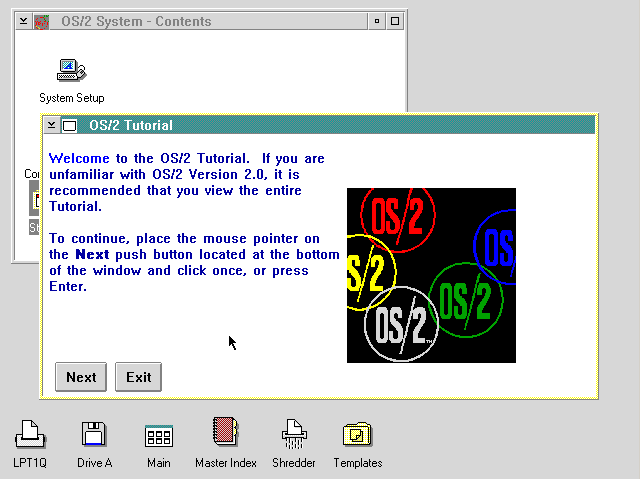 So as a ‘quick’ tour, here is the LA desktop.. .It’s… almost 2.0 but not quite there.
So as a ‘quick’ tour, here is the LA desktop.. .It’s… almost 2.0 but not quite there.
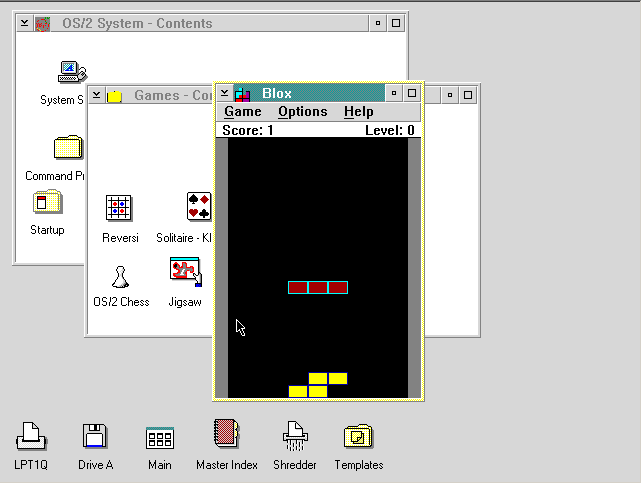 The LA includes a tetris clone, Blox that never made it to the GA.  I wonder if it’s a SDK example or maybe IBM didn’t want to get into licenses etc etc..
The LA includes a tetris clone, Blox that never made it to the GA.  I wonder if it’s a SDK example or maybe IBM didn’t want to get into licenses etc etc..
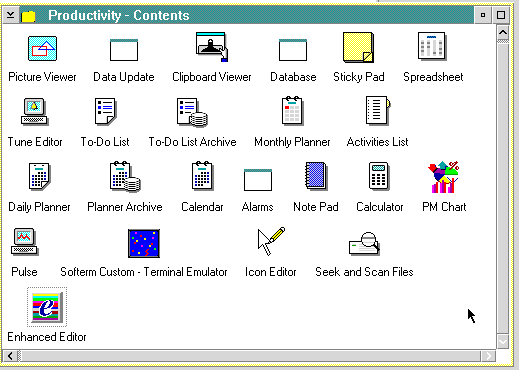 Also the applications were more or less the same, although there is some icon differences and it feels kind of rough around the edges as it isn’t finished but it does work.
Also the applications were more or less the same, although there is some icon differences and it feels kind of rough around the edges as it isn’t finished but it does work.
Another weird thing I noticed while looking to see if there was any exciting bitmaps in OS/2 2.0 LA, and finding it’s the same lighthouse. Â But something looked different, I’m amazed I even caught it. Â So I quickly fired up an OS/2 2.0 GA VM, and put them side by side. Â Do you see it?
For some reason, IBM edited out the American flag. Â I presume it was to make it more “international” but at the same point I had always assumed this lighthouse was in the USA. Â It does seem like a strange thing for an American company to do, as Americans always tend to slip stuff like flags & music into their products…
I figure someone out there who wants to run OS/2 LA will want this to get this OS running. At the same time, I haven’t even thought about seeing if LA upgrades 1.3 and how 2.0 GA overlays the LA.
When OS/2 4.0 came out, something was different. Â First it was 1996. Â The Windows 95 tidal wave had happened. Â Users everywhere were moving to Windows 95. Â Office 95 was also a big deal, a real 32bit version of Office that was sold on retail shelves, unlike Office for NT.
And if that onslaught wasn’t enough, a month earlier Windows NT 4.0 had hit the shelves.  And as I had mentioned it was so popular and so desired, where I worked people were going out and purchasing it themselves, and replacing their corporate sanctioned OS (Windows 3.11 or Windows 95) as the productivity of not crashing or the conflicts of old/bad drivers etc etc.
At this point to say OS/2 4.0 had significant competition is an understatement.  Not to mention how Microsoft leveraged it’s OEM channels to force bundling & instillation of Windows/Office, even on IBM hardware.
When I got OS/2 1.3 it was at a HAM Fest, as nobody sold it retail. Â OS/2 2.1 for Windows, and OS/2 Warp were all sold through retail channels. Â When OS/2 4.0 had finally gone retail none of the local retailers in the Ft Lauderdale, Miami area were going to even stock it. Â Instead me & a friend had to drive all the way up to some small retailer out around Boynton Beach. Â Needless to say this release wasn’t going to be a big one.
While the hype around Merlin, had been quite intense, when it had come time to deliver it seemed at this point IBM was only going to push this out because of all the time & effort that went into it. Â But the PowerPC version was basically dead, and it seemed with them the hope of OS/2 had gone with them.
Also at this point there were no plans to build a Win32 subsystem into OS/2.  This meant that you couldn’t run Office 95.  And of course when Office 97 came out, there was no way you would be running that on OS/2 either.  Oh sure there was this half hearted framework, Open32, 800 some popular Win32 calls adapted to OS/2, but it was only source compatible, there was no way it’d run stuff on OS/2 (while others have taken up the torch via Odin).
Ok, enough with the back story! Â Let’s upgrade!
 Hello old friend, it’s time to go to the end….
Hello old friend, it’s time to go to the end….
The installer had now swelled up to 3 disks. Â I’m not sure if 4.0 was even available on floppy disks. Â I know the version I had was on CD.
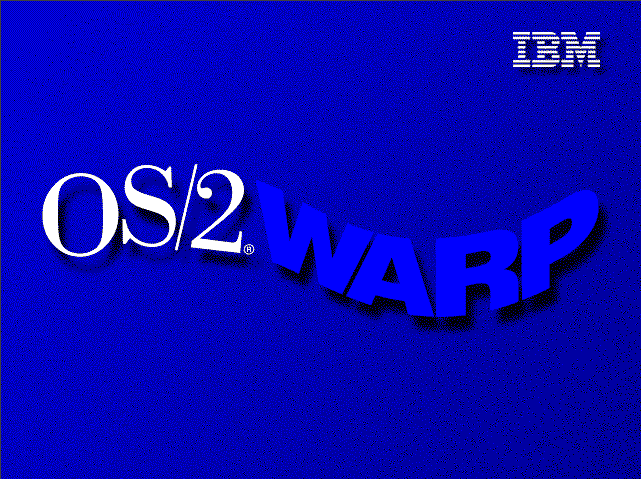 I’ve got to admit it, this boot logo looks the best.  Although in my opinion they should have dropped the Warp thing, at this point 4.0 was it’s own thing, and even in this logo they are using warp like a deformation, not warp speed.  Could it have been that hard to slap some Star Trek people on this?
I’ve got to admit it, this boot logo looks the best.  Although in my opinion they should have dropped the Warp thing, at this point 4.0 was it’s own thing, and even in this logo they are using warp like a deformation, not warp speed.  Could it have been that hard to slap some Star Trek people on this?
In this day in age, there would have been a ‘Jean Luc Piccard’ limited edition.  But I guess IBM wouldn’t want to offend the STAR WARS fans or something.
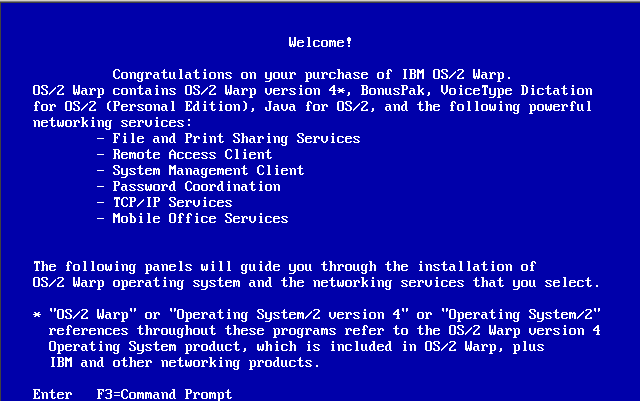 Well this is a change, a welcome screen touting new and exciting features!
Well this is a change, a welcome screen touting new and exciting features!
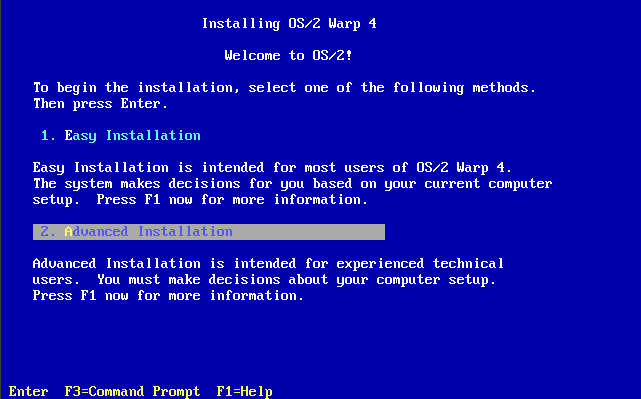 And it pretty much looks and feels like Warp 3’s colored installer, which we all know really goes all the way back to OS/2 1.1 . Â Especially when it comes to this:
And it pretty much looks and feels like Warp 3’s colored installer, which we all know really goes all the way back to OS/2 1.1 . Â Especially when it comes to this:
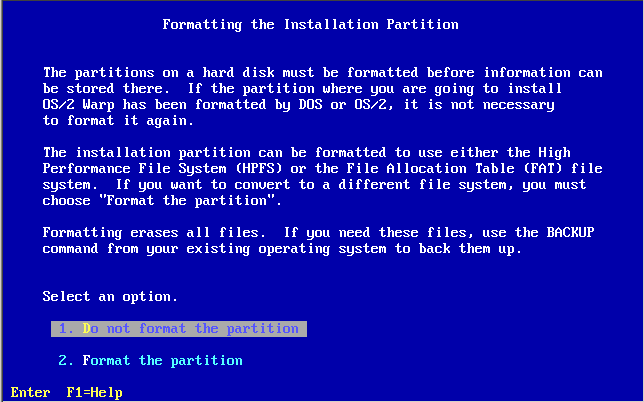 Yep let’s NOT format the disk. Â Although in retrospect I think I really did only half read this once, and I just saw the “convert to a different file system” part and said oh yeah let’s do this HPFS thing! … Too bad I missed the “erases all files”… Maybe a blink tag would have been appropriate there… Oh well it’s been a long long time since then.
Yep let’s NOT format the disk. Â Although in retrospect I think I really did only half read this once, and I just saw the “convert to a different file system” part and said oh yeah let’s do this HPFS thing! … Too bad I missed the “erases all files”… Maybe a blink tag would have been appropriate there… Oh well it’s been a long long time since then.
 Now with OS/2 prepped, it’s time to go into the GUI boot…!
Now with OS/2 prepped, it’s time to go into the GUI boot…!
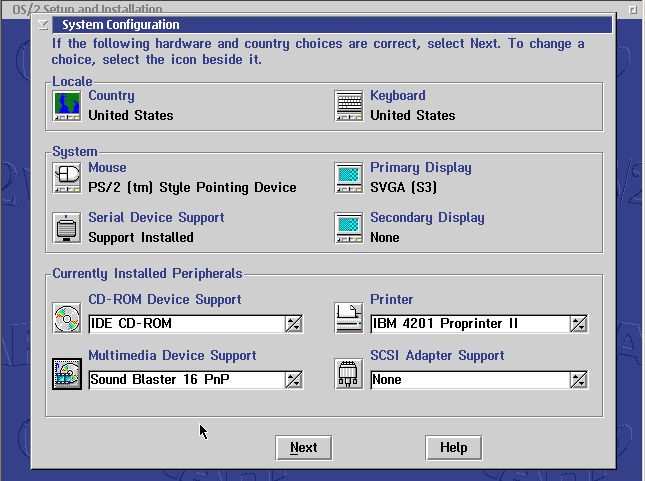 Oddly enough the Sound Blaster was not preserved from Warp. Â And at least in a virtual machine I do have the ability to test, and quickly go redo this, so I know the “Sound Blaster 16 PnP” works best in Virtual PC 2007. Â And as you can see it picks up the S3 video, and it remembered my printer! Â But it still asks me to go thru a list of printer & video drivers, I guess it’s to make sure they are correct. Â I just hope this doesn’t leave me with 3 printers…
Oddly enough the Sound Blaster was not preserved from Warp. Â And at least in a virtual machine I do have the ability to test, and quickly go redo this, so I know the “Sound Blaster 16 PnP” works best in Virtual PC 2007. Â And as you can see it picks up the S3 video, and it remembered my printer! Â But it still asks me to go thru a list of printer & video drivers, I guess it’s to make sure they are correct. Â I just hope this doesn’t leave me with 3 printers…
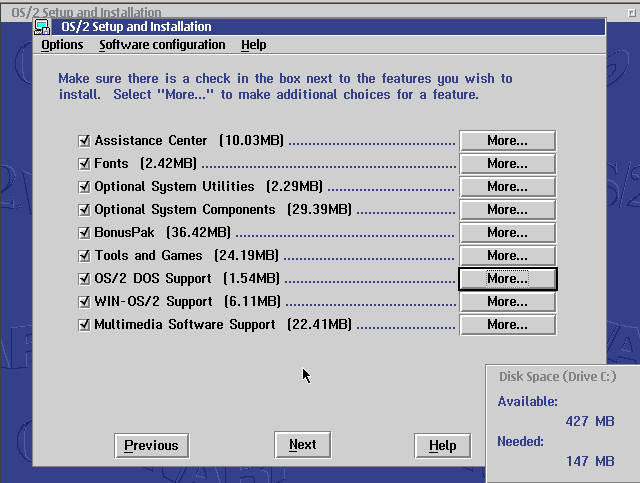 And as a sign of the times.. My 500MB disk is looking pretty small with all these features.
And as a sign of the times.. My 500MB disk is looking pretty small with all these features.
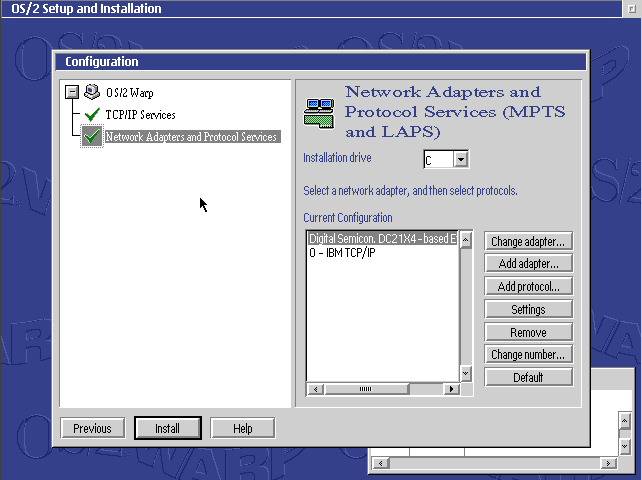 It does support DHCP, and it found the DC21x4 network card in Virtual PC. Â So far it looks pretty good!
It does support DHCP, and it found the DC21x4 network card in Virtual PC. Â So far it looks pretty good!
Let’s let the installer do it’s thing!
Also you may notice that OS/2 4.0 looks nothing like the prior versions. Â Gone is the old 5 color flag thing, and in with the ‘warp bounce’ thing.
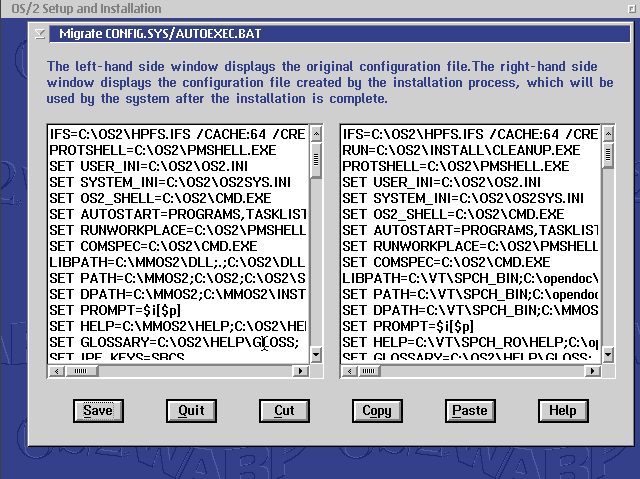 I’m sure all of this is helpful to someone. Â But it’s not me. Â I just assumed it knows what it’s doing.
I’m sure all of this is helpful to someone. Â But it’s not me. Â I just assumed it knows what it’s doing.
 A quick reboot and um.. it’s doing something. Â I guess someone had a placeholder in there…
A quick reboot and um.. it’s doing something. Â I guess someone had a placeholder in there…
Then another reboot and…
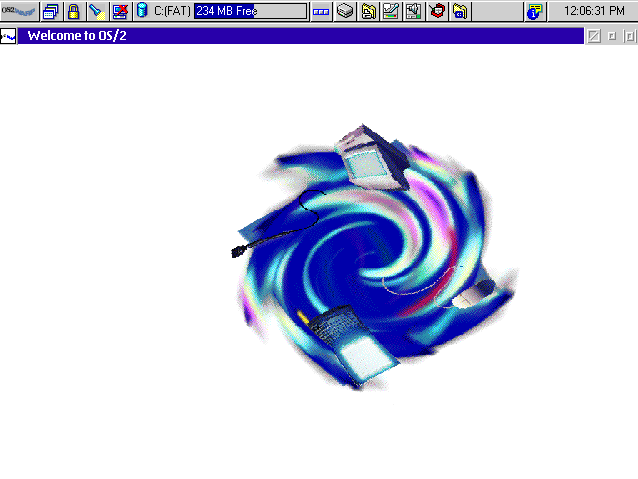 There is this weird animation of a computer and a LAN going down the drain or something..
There is this weird animation of a computer and a LAN going down the drain or something..
 Then we get this welcome screen. Â Closing out of this, I get to the desktop!
Then we get this welcome screen. Â Closing out of this, I get to the desktop!
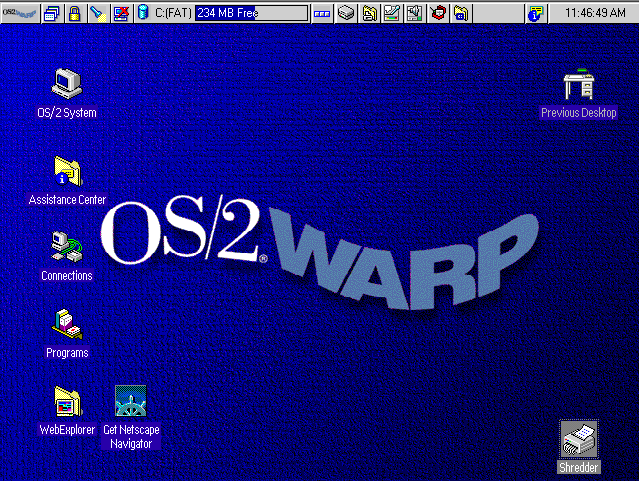 Which is… different. Â It sure looks like *NOTHING* desktop wise was preserved.
Which is… different. Â It sure looks like *NOTHING* desktop wise was preserved.
Although I do like the status bar up top. Right away I know I’m using more then half my disk!
And there is some OS/2 answer to the start menu..
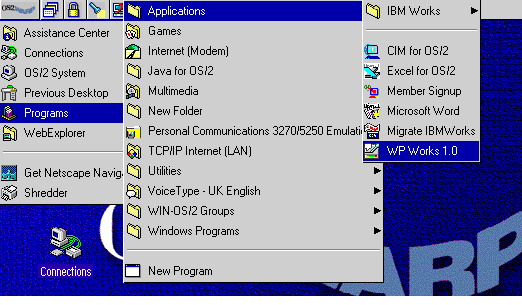 Which in the world of Windows 95/NT 4 feels. Weird. Â So quickly let’s see how we stack up in terms of legacy applications.
Which in the world of Windows 95/NT 4 feels. Weird. Â So quickly let’s see how we stack up in terms of legacy applications.
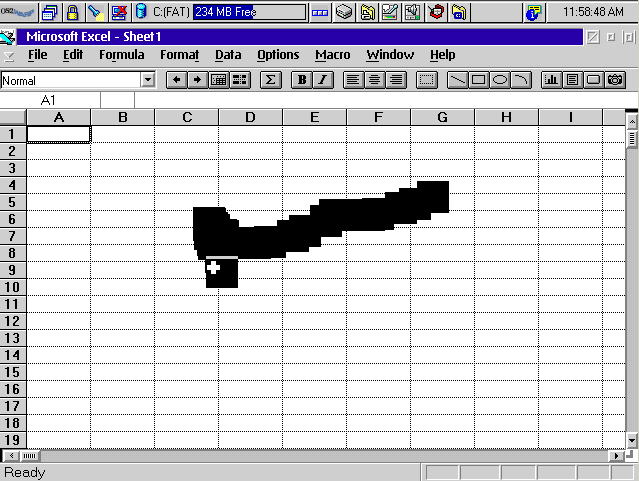 Excel acts weird. Â I don’t know if this is to blame on the new graphics drivers, or what. Granted Excel is circa 1991 but it’s worked up to this point.
Excel acts weird. Â I don’t know if this is to blame on the new graphics drivers, or what. Granted Excel is circa 1991 but it’s worked up to this point.
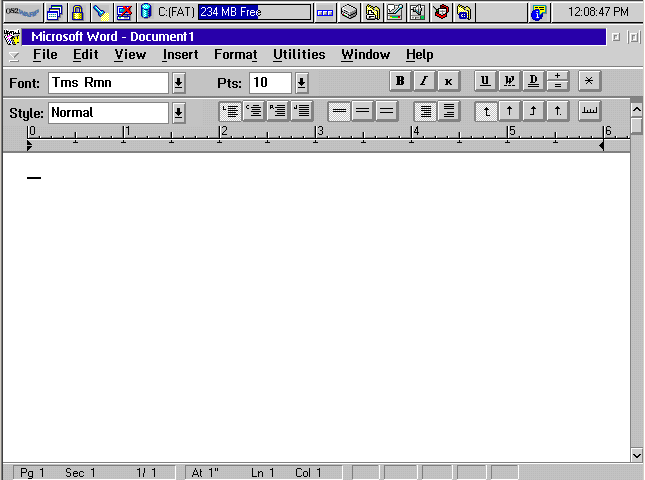 Ironically, Word 1.1 for OS/2 works great. Â Although it’s far obsoleted in terms of it’s document format, left behind by Word 2 for Windows, this version just keeps on rocking. Â I can’t help but wonder if I had an older version of Excel that it may have worked better.
Ironically, Word 1.1 for OS/2 works great. Â Although it’s far obsoleted in terms of it’s document format, left behind by Word 2 for Windows, this version just keeps on rocking. Â I can’t help but wonder if I had an older version of Excel that it may have worked better.
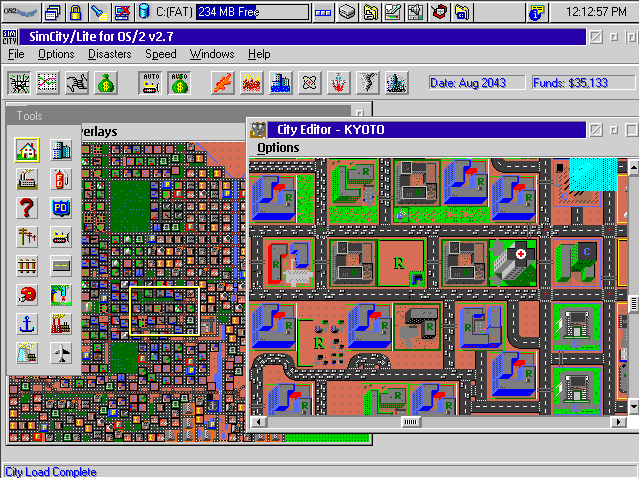 SimCity loads up and plays fine. No weird artifacts. Â Even digging through the old desktop folder I find my old stuff from OS/2 1.1 and I fire up bricks.
SimCity loads up and plays fine. No weird artifacts. Â Even digging through the old desktop folder I find my old stuff from OS/2 1.1 and I fire up bricks.
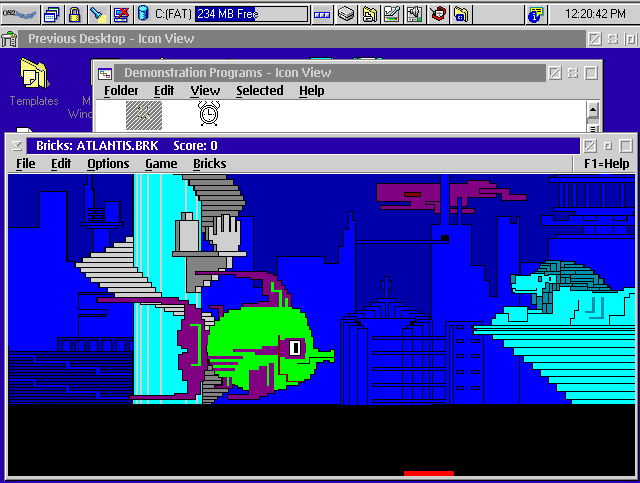 So far so good. Â Seeing I found my old applications, let’s see about games & all the desktop accessories we’ve collected since OS/2 2.0
So far so good. Â Seeing I found my old applications, let’s see about games & all the desktop accessories we’ve collected since OS/2 2.0
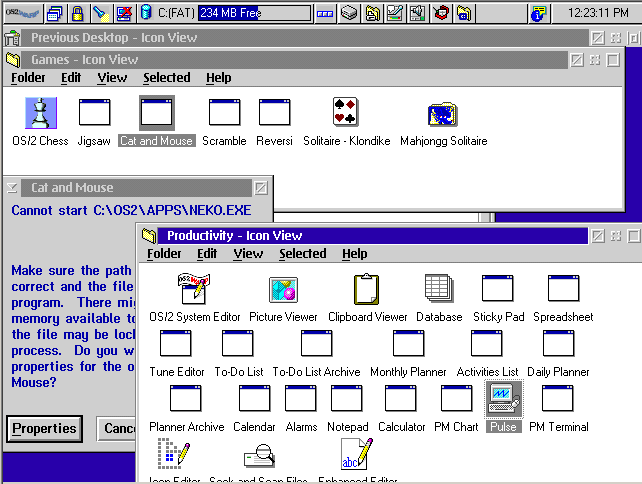 Talk about horrible! Â They are almost all GONE! Â Even poor Neko didn’t make the cut! Â And yet gwbasic 3.23 from OS/2 1.0 made it. Â Honestly I really feel let down by IBM at this point.
Talk about horrible! Â They are almost all GONE! Â Even poor Neko didn’t make the cut! Â And yet gwbasic 3.23 from OS/2 1.0 made it. Â Honestly I really feel let down by IBM at this point.
Another thing that didn’t make the cut was my Win32s install.  It was completely removed. I almost wonder what would have happened if I’d installed apps in OS/2 2.0’s Windows 3.0 .. I may have to time travel to find out.
Also any attempts at running MS-DOS in a full screen freezes OS/2. Â Looking at the Excel glitch I can’t help but feel it’s a video driver thing.
I know this post is very heavy in terms of pictures, and there is a lot of ground to cover in this final release of OS/2 (I’m counting 4.0 as the last one as it’s the last one I’ve ever used, and I don’t think that 4.5 was even attempted to be marketed in a retail fashion, and I really can’t justify the $$$ for ecomstation.. but maybe I’ll see if there is a demo…)
I’ll try to cover some of the new features, in the next post.
Continuing from my previous post, I scored a lot of OS/2 Warp 3.0 media on ebay, and a kind person sent me some disk images of Warp 3.0 blue spine!
Now the downside is that while Virtual PC 2007 supports XDF to some extent, it doesn’t like the XDF driver that comes with Warp 3.0… Which I guess isn’t a surprise, anyone would after all be loading the latest version, I mean who would load up and upgrade every version of OS/2 for the heck of it?
So as it is pointed out here, simply replace the ibm1flpy.add & xdfloppy.flt from OS/2 4.0 and it’ll work!
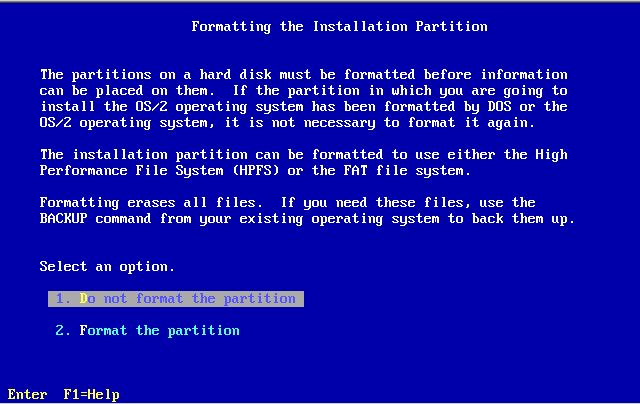 Now we get the usual, do we want to format my disk… As always the answer is NO… But it’s so delightfully colorful now!
Now we get the usual, do we want to format my disk… As always the answer is NO… But it’s so delightfully colorful now!
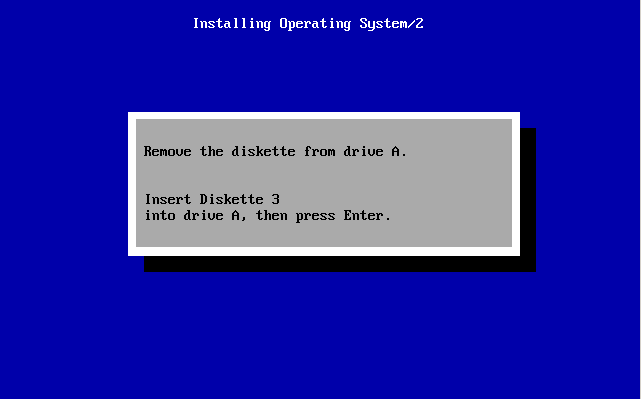 Then it’s a simple matter of feeding it disks, and waiting for it to chew through the 6 disks… Â I remember on a physical machine, these XDF’s weren’t exactly speedy.
Then it’s a simple matter of feeding it disks, and waiting for it to chew through the 6 disks… Â I remember on a physical machine, these XDF’s weren’t exactly speedy.
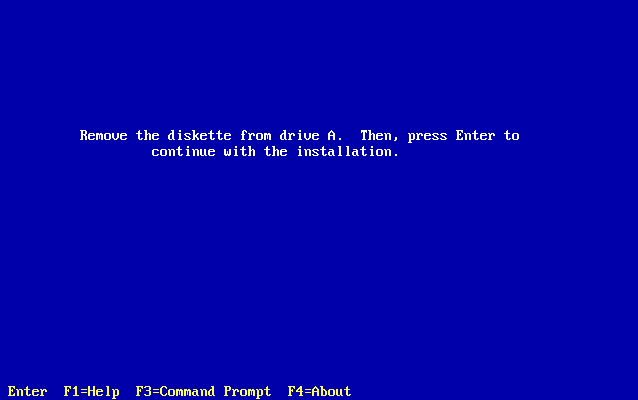 And then with that out of the way, it’ll be time to reboot, into the GUI, and to see how much hardware (if any) has been preserved.
And then with that out of the way, it’ll be time to reboot, into the GUI, and to see how much hardware (if any) has been preserved.
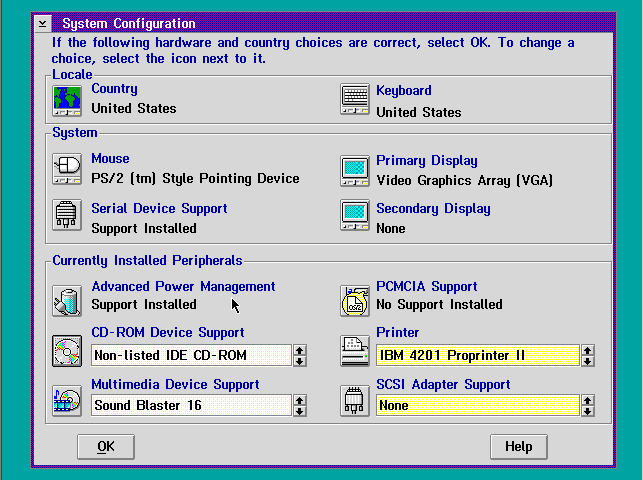 I had to change the Video to regular VGA, for some reason it this this is a Chips video…? And it had no idea about the CD-ROM. Â It did pick up the sound blaster, and it kept my printer!
I had to change the Video to regular VGA, for some reason it this this is a Chips video…? And it had no idea about the CD-ROM. Â It did pick up the sound blaster, and it kept my printer!
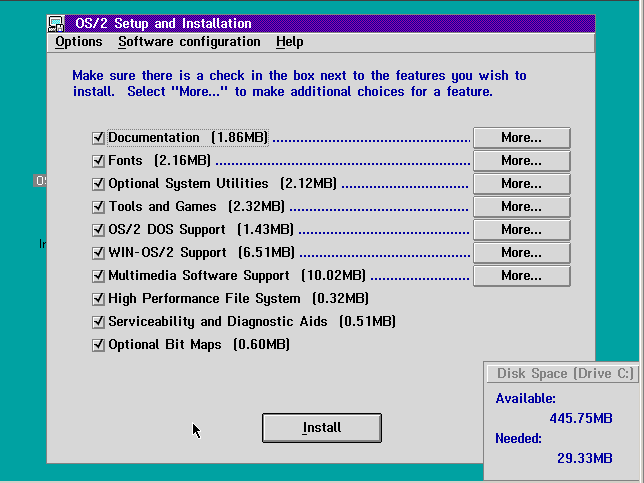 Wow fully loaded out, and 29.33MB. Â I can’t remember the last time getting so much out of so little. Â Anyways, time to swap more disks…
Wow fully loaded out, and 29.33MB. Â I can’t remember the last time getting so much out of so little. Â Anyways, time to swap more disks…
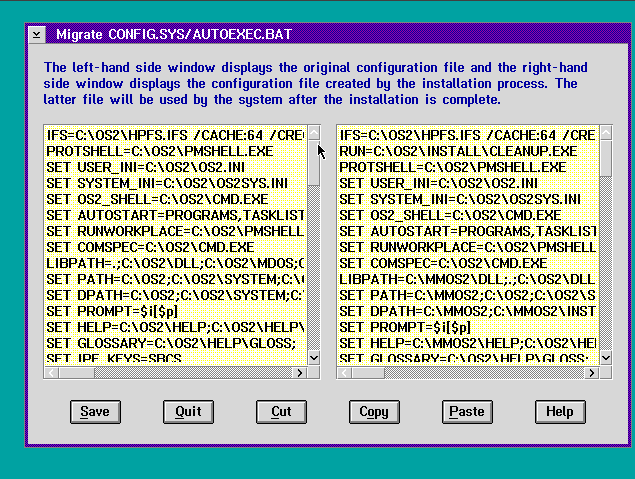 And as part of the update, it’ll let you compare your config.sys with a before and after… And honestly… WTF?  Since the lines are so long, why did someone thing this was actually legible?
And as part of the update, it’ll let you compare your config.sys with a before and after… And honestly… WTF?  Since the lines are so long, why did someone thing this was actually legible?
I know it’s part of the legacy of config.sys, but really.. WTF!
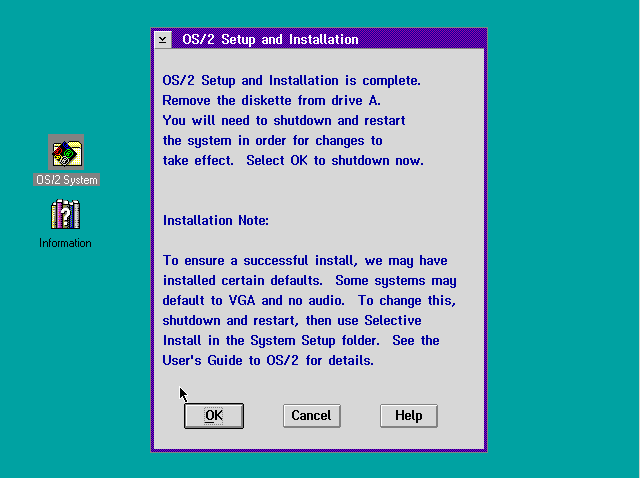 Well we’ll just trust it’s upgrade process, and let it ride!
Well we’ll just trust it’s upgrade process, and let it ride!
So we reboot, another splash logo and….
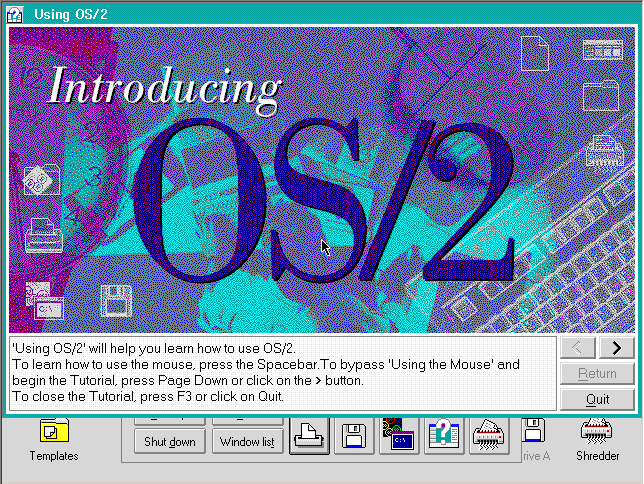 We not only get the desktop, the tutoral, Introducing OS/2. Â Which is really nice looking. Â It’s like they hired someone that’s not old school IBM to do this. Â It’s at least a big enough of a change since the days of OS/2 1.2’s tutorial.
We not only get the desktop, the tutoral, Introducing OS/2. Â Which is really nice looking. Â It’s like they hired someone that’s not old school IBM to do this. Â It’s at least a big enough of a change since the days of OS/2 1.2’s tutorial.
Closing that, I get the desktop. Â I’m no fan of the launchpad, so I just shred that thing from the get go. Â I know I know.. it’s like windows 95’ish but from 1994.
And how did my legacy applications hold up?
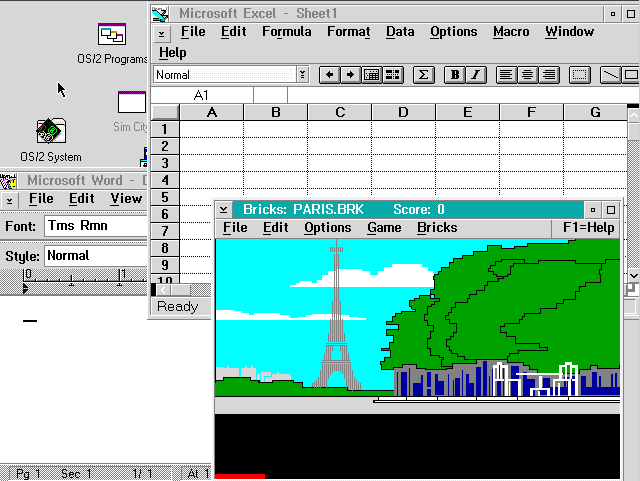 Bricks from OS/2 1.1 is still there, and still works great. Â Word & Excel also working, just as they did when I installed them in OS/2 1.2.
Bricks from OS/2 1.1 is still there, and still works great. Â Word & Excel also working, just as they did when I installed them in OS/2 1.2.
Even SimCityLite is working, along with DOOM. Â I’d have to give Warp an A+ on it’s migration from OS/2 2.1. Â It did look a little scary with the config.sys thing from hell, but really you can tell a *LOT* of work went into this release of OS/2.
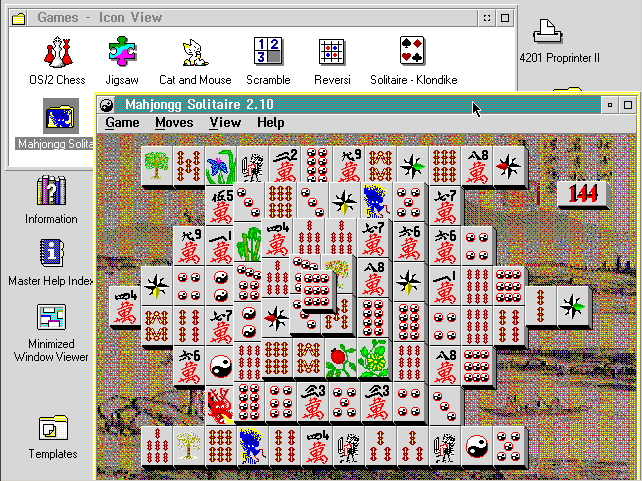 Speaking of games, Warp gave us.. Mahjongg Solitaire.  I don’t know why it’s not spelled Mahjong, maybe it’s some British English vs US English thing?  Anyways I’ve always associated the game with old ladies, and gambling rings.  Honestly IBM would have been better off paying out some developer for a ‘top selling game’ and doing an OS/2 version.  Even in OS/2 2.0 it is possible to write 32bit programs that’ll run in VGA 320x200x256 mode, which was still popular with plenty of the MS-DOS games of the time.  But I guess even a full screen port of DOOM wouldn’t be all that IBM GREY/PC/DULL enough.  Oh well even Tetris would have been a popular game.
Speaking of games, Warp gave us.. Mahjongg Solitaire.  I don’t know why it’s not spelled Mahjong, maybe it’s some British English vs US English thing?  Anyways I’ve always associated the game with old ladies, and gambling rings.  Honestly IBM would have been better off paying out some developer for a ‘top selling game’ and doing an OS/2 version.  Even in OS/2 2.0 it is possible to write 32bit programs that’ll run in VGA 320x200x256 mode, which was still popular with plenty of the MS-DOS games of the time.  But I guess even a full screen port of DOOM wouldn’t be all that IBM GREY/PC/DULL enough.  Oh well even Tetris would have been a popular game.
One thing that bugged the hell out of me was the sounds. Â It still was annoying to use OS/2 in an office with it constantly making noise… But in all fairness it was kind of the rage of the time, even Windows to this day has all the hooks in for it’s themes of custom mouse pointers, and GUI actions. Thankfully we’ve all moved beyond that.
This was going to be the the effort to really wow people before Windows 95 shipped.  In some regards it really was too little too late.  The world was shifting away from the idea of an isolate powerful ‘workstation’ to the connected computer.  As it does say on the box, this was the ‘on ramp to the information super highway.  In my opinion this is where OS/2 weakspots really started to show through.  First TCP/IP was an addon, not part of the OS.  I don’t know how they thought slapping other diskettes in the box is ‘ok’ but it’s not part of the default install, and easily missed by novice users.  The next, and forever lamented part is that it only included support for dialup.
That’s right, although dialup was pretty much the norm for 1994, the world was rapidly changing, and the first cable modems were starting to be slowly rolled out.  It also meant in the corporate world as LANS had taken over everything, and companies were just starting to think about TCP/IP and internet strategies, OS/2 was setup to be left out.  Instead, someone at IBM decided that LAN based network should be a premium and people should pay twice the price for OS/2 Warp connect.  This proved disastrous.
Right about this time, Microsoft had released Windows for Workgroups, which was all about LAN / NetBEUI access, but they even did throw out a free TCP/IP protocol upgrade. Â Windows NT 3.1 had finally shipped, and it too included LAN TCP/IP support. Â Then it was cemented in the more responsive Windows NT 3.5 which had a smaller memory footprint, and of course included support for PPP/SLIP along with LAN networking, and support for IP forwarding! Â That’s right you could use Windows NT 3.5 as a router!.. (Yes, even the workstation version).
However IBM did at least have the foresight to include popular internet programs in their internet pack (which sadly I don’t have.  I’ll have to review it later), I recall it had a gopher client, NNTP client (Probably News/2 from the TCP/IP for OS/2 2.0 days) and a cut down version of LAMAIL…
The other massive shift online was the coming rise of the web browser. Â Specifically Mosaic. Â And Mosaic ran on all kinds of UNIX platforms. Â It even ran on Windows NT. Â They even made it ‘safe’ enough to run on Win32s. Â But there was no port to OS/2. Â Thankfully someone recognized the importance of Win32s, and provided a driver to interface Windows 3.1’s 386 enhanced mode, to a workalike driver for Win32s.
 I chose the ‘runtime’ version of Win32s 1.1 .. I just wanted to see if it’d work.
I chose the ‘runtime’ version of Win32s 1.1 .. I just wanted to see if it’d work.
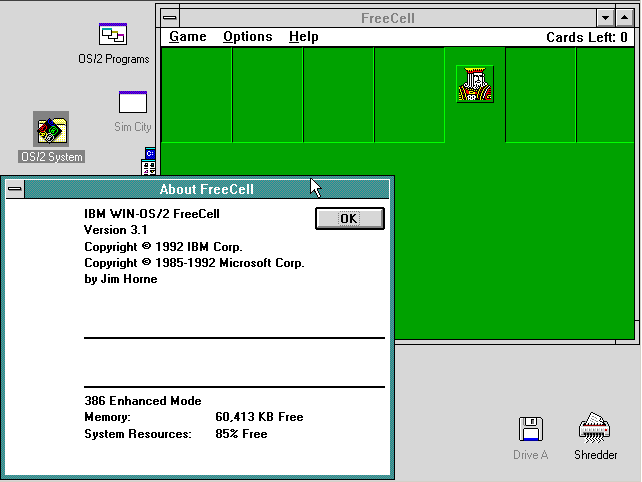 And the good news is that not only did it work, but it runs in seamless mode, with OS/2 1.1’s color scheme. Â Pretty snazzy.
And the good news is that not only did it work, but it runs in seamless mode, with OS/2 1.1’s color scheme. Â Pretty snazzy.
There was a short windows, but it was there, while people were on dialup, and before Windows 95 had shipped and had some extended driver support under it’s belt, OS/2 was the best way to run Win32s stuff outside of Windows NT. Â But even people who had devices like this thing I had at the time:
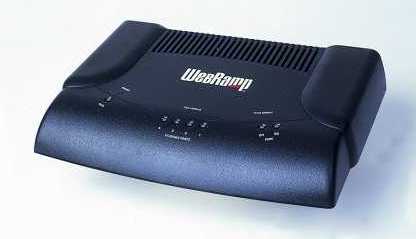 The web ramp was really cool, it had 3 serial ports, which let you connect 3 modems. Â It would then round robin your outbound requests so that people could share all 3 lines (if you had them) and it did NAT in hardware. Â This mean in the age of dialup this little guy would let you build a small LAN (it had a 4 port ethernet hub in the back) and suddenly all the computers at home with ethernet were online. Â It’s stuff like this that really left people asking why did OS/2 warp have such a substandard networking stack.
The web ramp was really cool, it had 3 serial ports, which let you connect 3 modems. Â It would then round robin your outbound requests so that people could share all 3 lines (if you had them) and it did NAT in hardware. Â This mean in the age of dialup this little guy would let you build a small LAN (it had a 4 port ethernet hub in the back) and suddenly all the computers at home with ethernet were online. Â It’s stuff like this that really left people asking why did OS/2 warp have such a substandard networking stack.
The year was 1994, the internet was starting to gain momentum.  Windows 95 was a year and a half away.  The answer to Windows 95 would no doubt be OS/2 4.0.  Would IBM do anything about these shortcomings?
We’ll find out as we upgrade to ‘project Merlin’ AKA OS/2 4.0.
Well the time has come to install OS/2 Warp. Â But first a quick commercial:
It’s not secret that this is regarded as one of the worst advertising campaigns in the history of the world. Â Watch it and remember this ad aired on American TV. Â If you want to alienate people first speak to them in a foreign language that they have no hope of understanding. Â Next get people who clearly are not users of that product to promote it. Â And finally… DON’T SHOW THE PRODUCT.
Nobody wanted to get ‘warped’. Â After all warped rotors cost people a LOT of money.. Bad connotations, you know. Â But apparently nobody with any common sense asked what the hell was this crap.
Anyways, let’s go and do the upgrade.
Old blue, forever there…. forever… IBM.
Oh what’s this? Â A new boot logo! Clearly this isn’t OS/2 2.x!
I can feel the excitement already! Â So I’m going to take the easy way out, right? It should.. keep my printer, keep my applications, and get me warped right!?
The best part about Warp is that it supports IDE CDROMs out of the box! Outside of the boot disks, no more floppy shuffle!
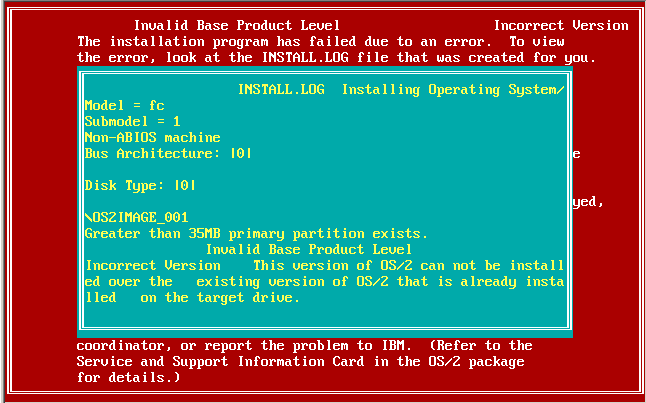 Well of course I have a greater then 35MB disk, Invalid Base Product Level? Â What is so wrong with OS/2 2.11? Â I have a bad feeling my OS/2 3.0 CD is one of the ‘red spine’ varieties that includes no Win-OS/2 support but rather relied on the user to provide a regular copy of Windows 3.1 … And for some reason it won’t upgrade a prior Win-OS/2 installation.
Well of course I have a greater then 35MB disk, Invalid Base Product Level? Â What is so wrong with OS/2 2.11? Â I have a bad feeling my OS/2 3.0 CD is one of the ‘red spine’ varieties that includes no Win-OS/2 support but rather relied on the user to provide a regular copy of Windows 3.1 … And for some reason it won’t upgrade a prior Win-OS/2 installation.
Oh well. Â I’ll have to dig around some more for a ‘red’ spine copy of Warp 3 …
I guess for now this is a ‘work in progress’.. but I’ll get OS/2 all the way to 4!
—- Edit
Some kind person sent me some disk images, so onward to Warp 3!
Kicking off the install we get our old friend the IBM logo. Â At least they get to re-use stuff over and over and over…
And… the old welcome screen. Â Sometimes it’s hard to know what version you are installing. Â Well other then the mountain of diskettes! It’s 23 disks by now!
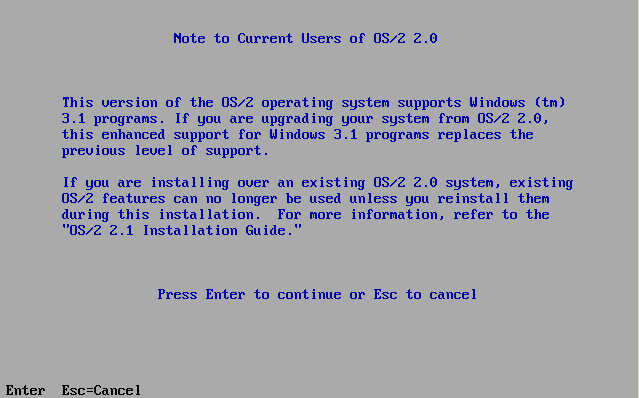 This sounds.. foreboding.  I guess we’ll find out as we go along.
This sounds.. foreboding.  I guess we’ll find out as we go along.
 And once more again, OS/2 can be installed in all kinds of places.. And to keep the upgrade cycle going we are going to remain on the C drive…
And once more again, OS/2 can be installed in all kinds of places.. And to keep the upgrade cycle going we are going to remain on the C drive…
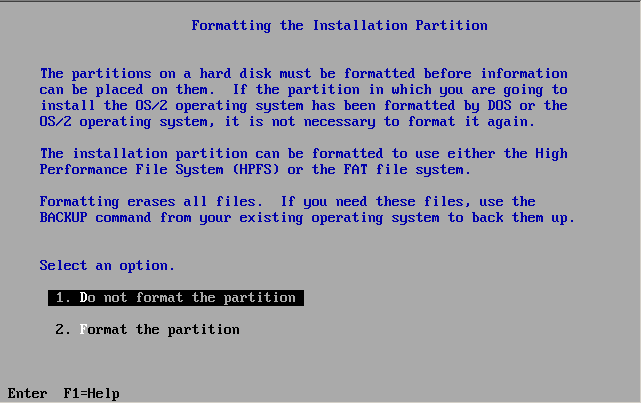 I guess by now I should get used to OS/2 trying to offer to format my hard disk.
I guess by now I should get used to OS/2 trying to offer to format my hard disk.
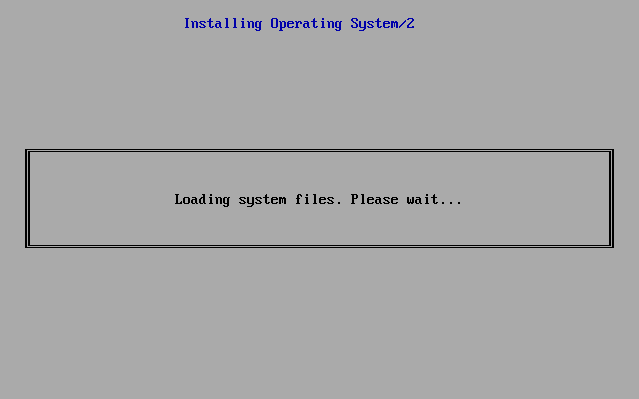 Time to feed the machine a bunch of disks…
Time to feed the machine a bunch of disks…
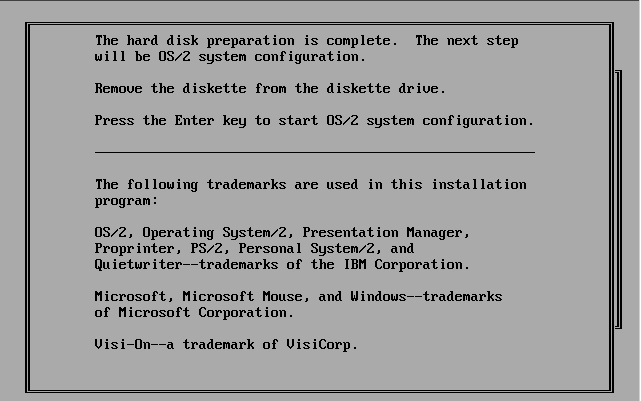 And now we are ready to boot up the GUI… Again is this OS/2 2.0 or 2.1? It’s hard to tell.
And now we are ready to boot up the GUI… Again is this OS/2 2.0 or 2.1? It’s hard to tell.
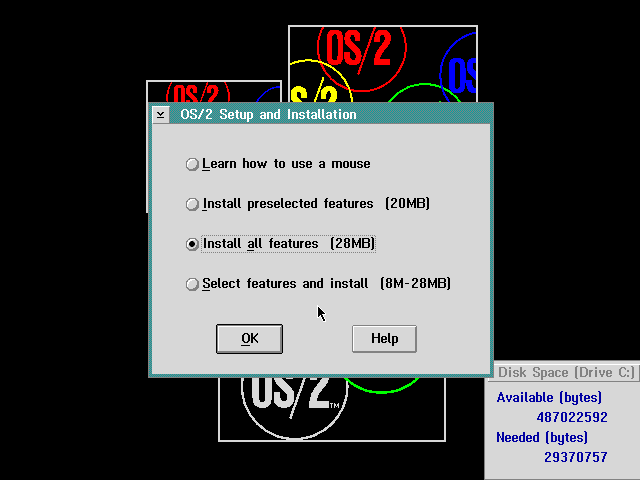 And let’s install the whole thing… wee!
And let’s install the whole thing… wee!
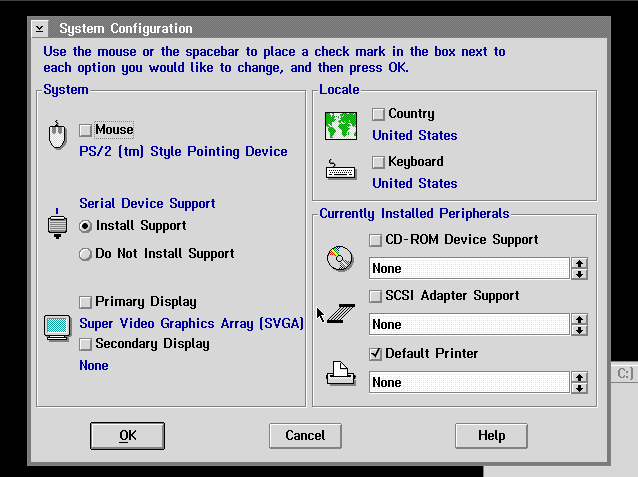 Well this is new.. CD-ROMs were becoming more and more popular. Â Sadly the IDE CDROM standard had not been invented yet. Â So… going stock, no IDE-CDROMs yet.
Well this is new.. CD-ROMs were becoming more and more popular. Â Sadly the IDE CDROM standard had not been invented yet. Â So… going stock, no IDE-CDROMs yet.
 And once more again I have to select the IBM Proprinter II and assign it to LPT1. Â Why oh why am I constantly having to do this? Â There is no real logic as to why some versions migrate this, and others do not.
And once more again I have to select the IBM Proprinter II and assign it to LPT1. Â Why oh why am I constantly having to do this? Â There is no real logic as to why some versions migrate this, and others do not.
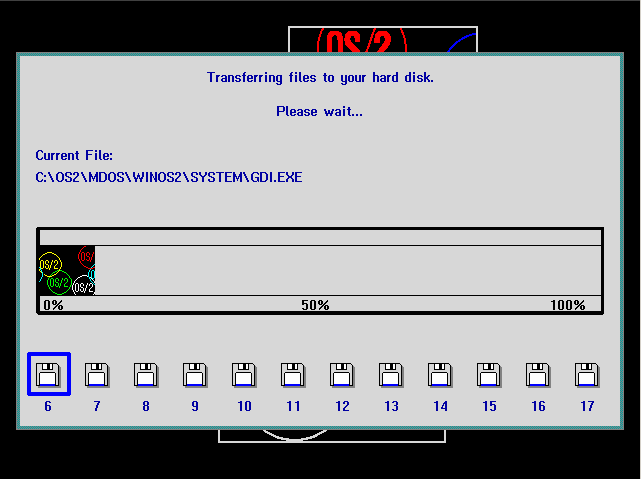 Time to feed some disks to the computer, and wonder about that warning…
Time to feed some disks to the computer, and wonder about that warning…
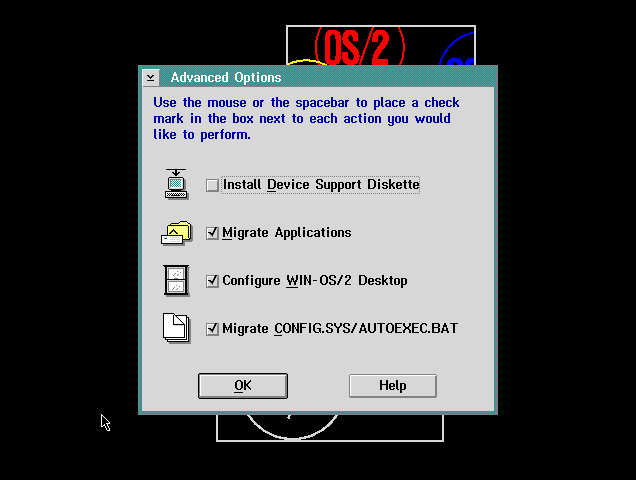 Didn’t we do this before? Â Again I’m going to go through with it…
Didn’t we do this before? Â Again I’m going to go through with it…
Worst case I’ll have two icon sets now for Word & Excel.
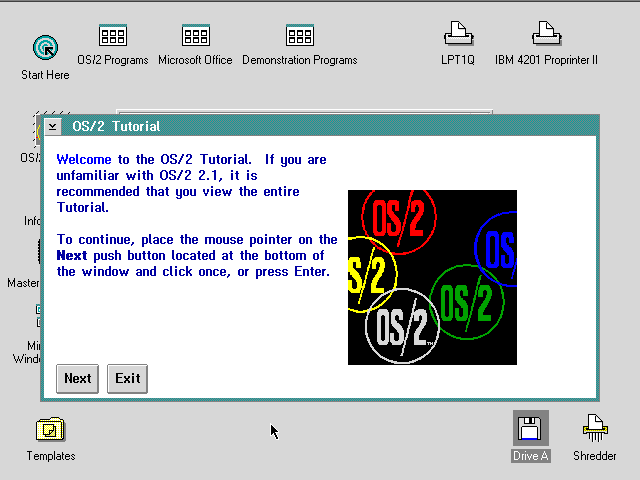 Ok, looks good.. OS/2 2.1 … Which to be honest looks identical to OS/2 2.0.
Ok, looks good.. OS/2 2.1 … Which to be honest looks identical to OS/2 2.0.
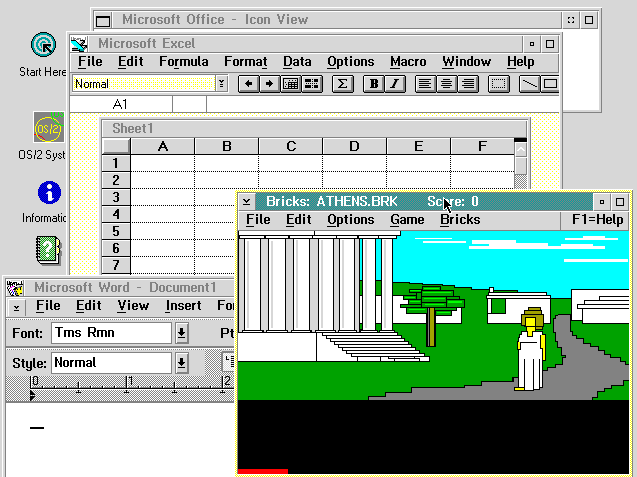 The good news is that Word and Excel still work, and Bricks the breakout clone from OS/2 1.1 is still working. Â I still have my two printers..
The good news is that Word and Excel still work, and Bricks the breakout clone from OS/2 1.1 is still working. Â I still have my two printers..
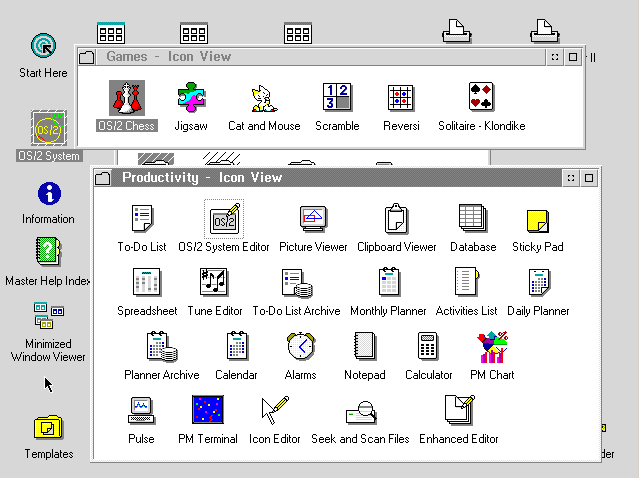 Games & Productivity look identical.
Games & Productivity look identical.
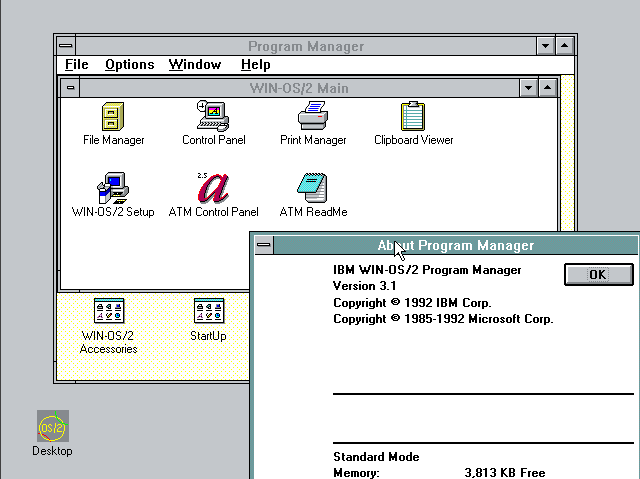 The ‘bigger’ deal is that Win-OS/2 was updated to Windows 3.1!
The ‘bigger’ deal is that Win-OS/2 was updated to Windows 3.1!
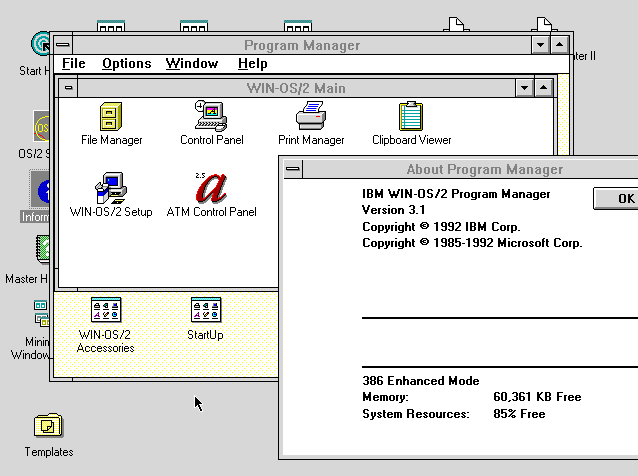 And it could now run in 386 Enhanced Mode, while OS/2 2.0’s Windows 3.0 was limited to ‘real’ and ‘standard’ (286 protected mode) modes of operation. Â The only big limitation was that you could not load any VXD’s into Windows 3.1. Â This made things like Win32s impossible to use. Â But again with it’s ability to isolate programs it made OS/2 a far superior platform for Windows applications.
And it could now run in 386 Enhanced Mode, while OS/2 2.0’s Windows 3.0 was limited to ‘real’ and ‘standard’ (286 protected mode) modes of operation. Â The only big limitation was that you could not load any VXD’s into Windows 3.1. Â This made things like Win32s impossible to use. Â But again with it’s ability to isolate programs it made OS/2 a far superior platform for Windows applications.
The other big use for OS/2 was BBSing. Â It’s ability to run multiple DOS sessions was a big deal. Â And if anything OS/2’s ability to multitask DOS so well made OS/2 versions of stuff kind of moot. Â Even Synchronet didn’t sell that many OS/2 versions fo the BBS (I know it was largely because the tremendous rise of the Internet really changed that).
The other ‘big’ thing for OS/2 2.1 was the addition of the multimedia extensions.  Sadly they were a separate install from the OS (WHY?!) and it seems with the shuffle of time I’ve misplaced my disks… I remember that it included some bird video, and Intel video codec, and sounds.  There was a sound effect for everything but moving the mouse.. And it was annoying as hell.  But it’s March of 1993, Windows NT 3.1 is about to launch, and Multimedia was on everyone’s mind.
Also as OS/2 started to garner attention things like Sim City started to appear.
Thanks to BlueNexus
One thing was for sure, to stand out the next version of OS/2 needed to look.. different. Onward to Warp!
Keeping with the ping-point tradition, I’m going to upgrade IBM OS/2 1.2 to Microsoft OS/2 1.30.1, the LAN Manager 2.1 install.  At this point Microsoft basically was taking IBM OS/2 1.3 and repackaging it.  All their efforts were shifting out of OS/2 and into Windows NT.  But to support existing customers and build their enterprise market OS/2 was still very much an integral part of the strategy as Windows NT wasn’t ready by a long shot yet.
Products like Microsoft Mail & SQL Server (ported & rebranded Sybase SQL) were the companies future direction, but for now they were OS/2 applications, and they needed an update from OS/2 1.2.
And continuing on, it’s the same bland tradition.
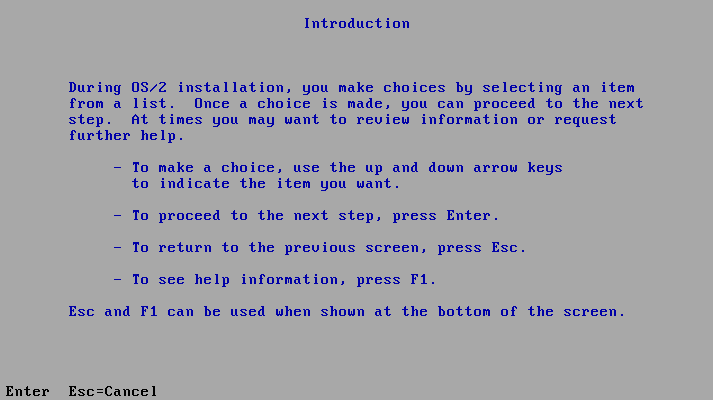 Maybe I just have mixed feelings about the grey background thing, it just feels either military or industrial.  Then again that was what OS/2 was trying to be, industrial computing on the PC.  I suspect there was a color study done by IBM on the whole look and feel.  The schema feels like a design by committee thing.
Maybe I just have mixed feelings about the grey background thing, it just feels either military or industrial.  Then again that was what OS/2 was trying to be, industrial computing on the PC.  I suspect there was a color study done by IBM on the whole look and feel.  The schema feels like a design by committee thing.
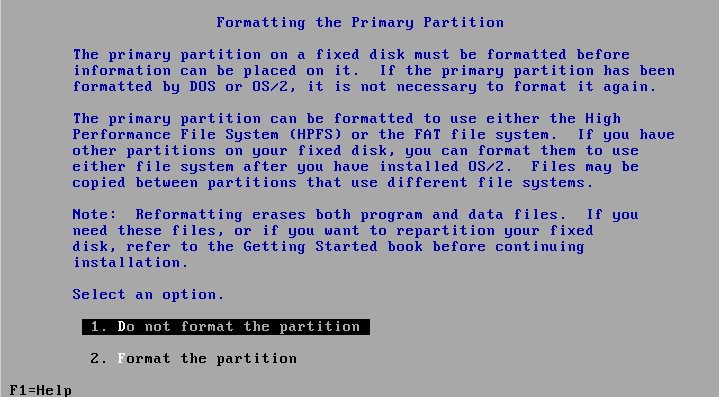 And please, don’t format my disk!
And please, don’t format my disk!
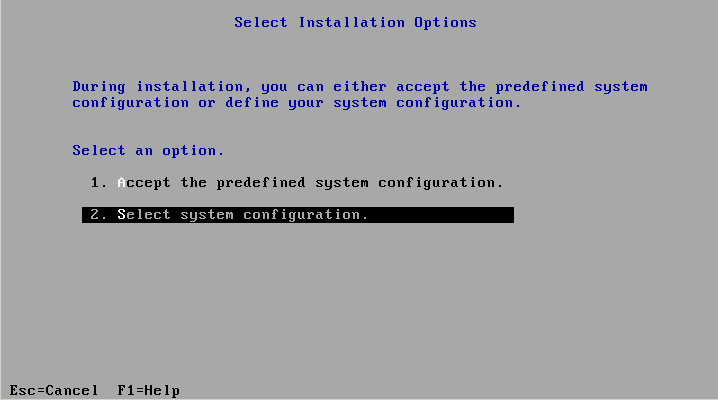 Now this selective installer is new.  Prior to this you’d get all of OS/2 and from there you could disable or delete as you wanted… But now a selective install.  I went ahead and selected everything.  Naturally this being a ‘server’ version you may not want the MS-DOS stuff at all…
Now this selective installer is new.  Prior to this you’d get all of OS/2 and from there you could disable or delete as you wanted… But now a selective install.  I went ahead and selected everything.  Naturally this being a ‘server’ version you may not want the MS-DOS stuff at all…
It sounds like a lot more stuff… But go through and select down the line. Â It is strange that my control+c (break) on is never honored, I have to always go there and enable it.
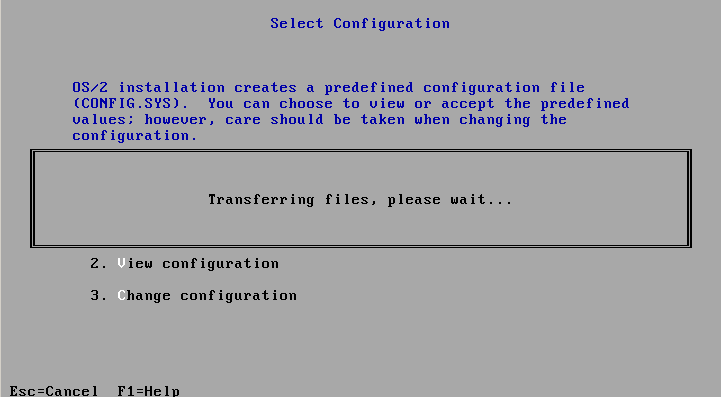 Now we just shuffle diskettes, and let the install finish up.
Now we just shuffle diskettes, and let the install finish up.
And to select a printer. Â I don’t know why it just doesn’t upgrade my old printer, maybe it just wants to show off all the drivers… A sharp contrast from OS/2 1.0!
So with the install done, and a quick reboot we are teleported to the OS/2 1.3 desktop.
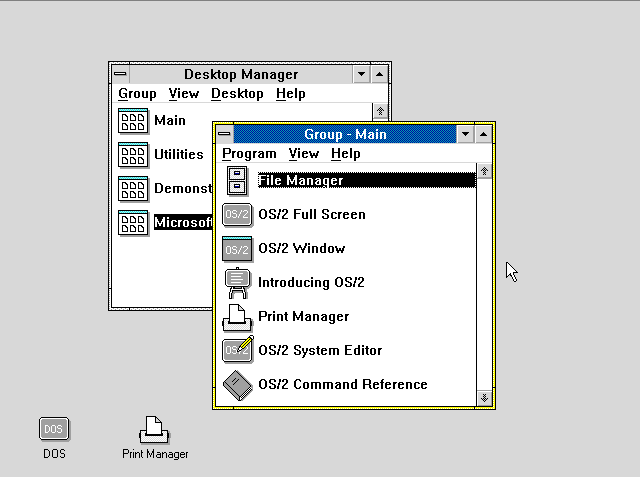 Very cool. Â And… very.. 1.2’ish.
Very cool. Â And… very.. 1.2’ish.
So I thought I’d first verify my applications work. Â Excel launches but Word..
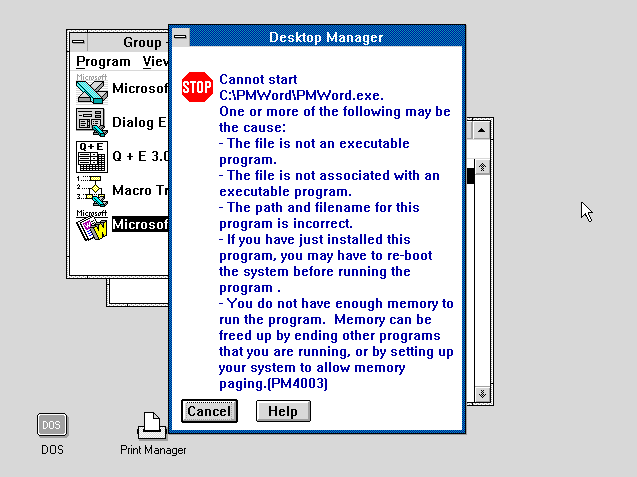 Ouch. Â I guess this Microsoft OS/2 doesn’t do upgrades. Â Although it did preserve my groups. I’ve got to say this is kinda sad. Â At least it did backup the config.sys so I could simply append the lines to the PATH & LIBPATH and get my applications running again. One can’t help but wonder if this was some passive aggressive attack on Word & Excel?
Ouch. Â I guess this Microsoft OS/2 doesn’t do upgrades. Â Although it did preserve my groups. I’ve got to say this is kinda sad. Â At least it did backup the config.sys so I could simply append the lines to the PATH & LIBPATH and get my applications running again. One can’t help but wonder if this was some passive aggressive attack on Word & Excel?
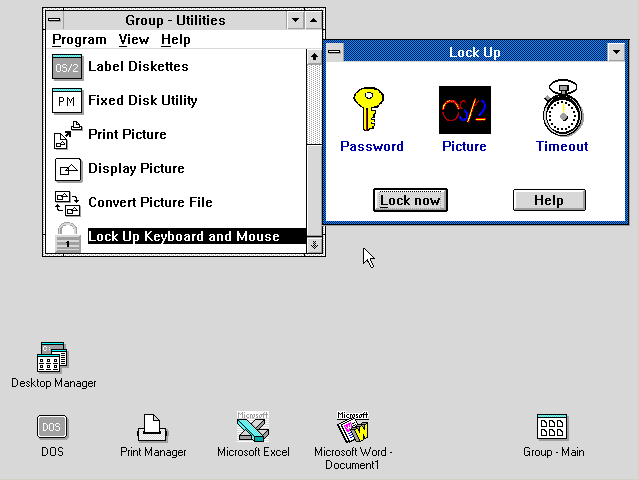 Also new in OS/2 1.3 is the ability to lock the desktop! Â Good stuff to keep people out, too bad it’s just a system thing, not an account / role based thing.
Also new in OS/2 1.3 is the ability to lock the desktop! Â Good stuff to keep people out, too bad it’s just a system thing, not an account / role based thing.
The default ‘screen saver’ lockout screen is the OS/2 logo. Â I’ve only seen it on the Microsoft BOX, and a few Microsoft books, but here it is.
OS/2 1.3 is said to be more stable then OS/2 1.2, and faster. Â I couldn’t tell the difference, I’m sure being under emulation would be one of the reasons, the other being on a significantly faster machine. Â Nobody could imagine Ghz CPUs in 1987.
I don’t have much to add to OS/2 1.3 as it really feels like OS/2 1.2.
Next up is OS/2 2.0, the first of the 32bit releases of OS/2… Operate at a higher level!
I couldn’t find a Microsoft OS/2 1.2 so on with IBM OS/2 1.2. Â I figured it was still a joint project that IBM should upgrade a Microsoft install.
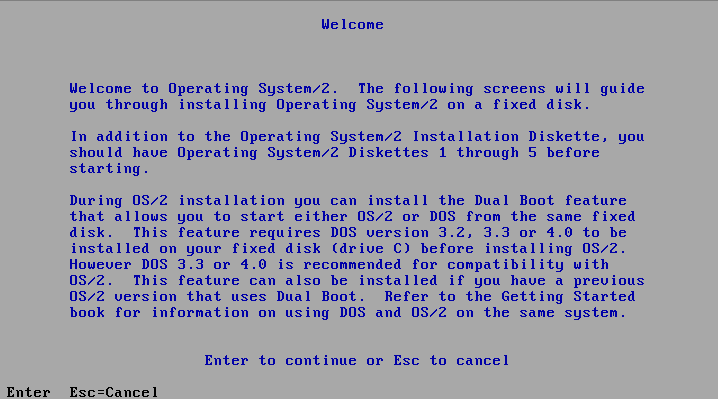 Into good old fashioned blue on grey. I’m not even going to bother with the dual boot thing, and anyways who cares, right, better dos then dos? right!
Into good old fashioned blue on grey. I’m not even going to bother with the dual boot thing, and anyways who cares, right, better dos then dos? right!
New in OS/2 1.2 is the HPFS filesystem. Â I could go on about it’s extended attributes, long file names, speed, but I’m sure others have written far better about it then me. Â Also how it didn’t have any journaling, could crash out easily, and there was no method to map longfilenames onto the 8.3 filesystem could easily leave DOS applications in the dark.
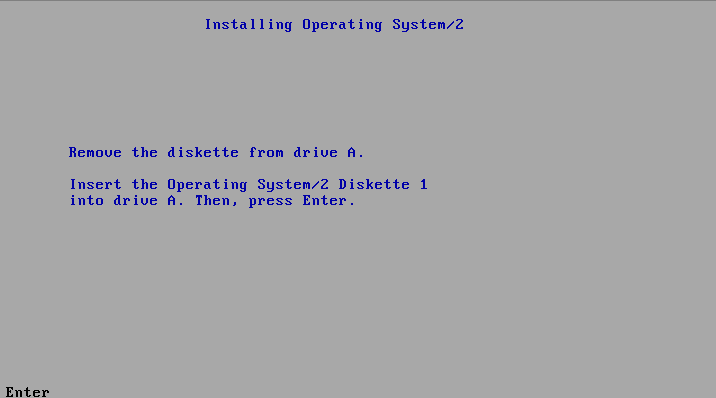 So basically we let it load and hit enter… select a keyboard and..
So basically we let it load and hit enter… select a keyboard and..
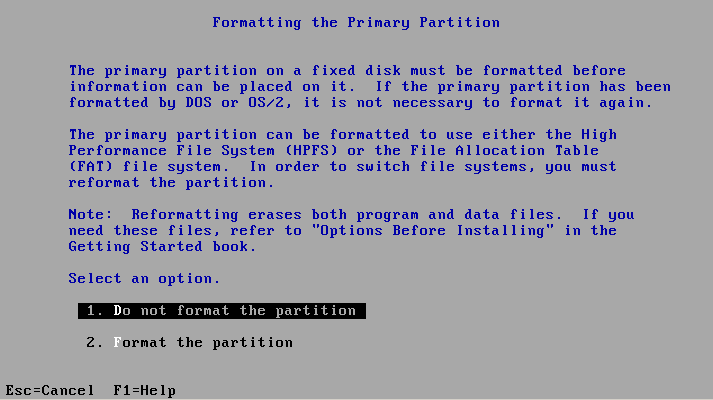 Again don’t let it format the disk. Â I wonder how many people went ahead and formatted thinking it’d preserve anything… Oh well we’ll keep things FAT for the duration of this exercise. Â Which reminds me, it’s a shame IBM/Microsoft didn’t include a tool to convert FAT to HPFS. Â I guess that was another lesson learned for WindowsNT.
Again don’t let it format the disk. Â I wonder how many people went ahead and formatted thinking it’d preserve anything… Oh well we’ll keep things FAT for the duration of this exercise. Â Which reminds me, it’s a shame IBM/Microsoft didn’t include a tool to convert FAT to HPFS. Â I guess that was another lesson learned for WindowsNT.
The install also asks if I’d like to keep my old program groups (yes!) and a mouse & serial port. Â The IBM OS/2 1.2 version has no support for PS/2 mice on AT computers. Â Oddly enough the PS/2 driver won’t load on VirtualBOX, so the real fix is to load the OS/2 1.3 PS/2 mouse driver on OS/2 1.2, add it to the mouse driver, and it’ll work fine.
So with the installation out of the way, let’s boot it up!
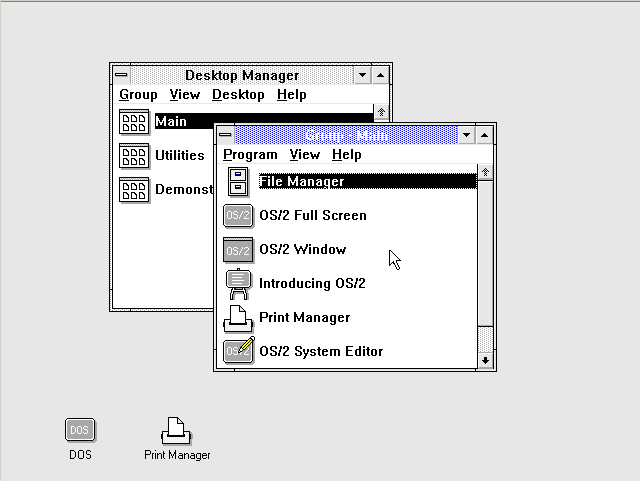 And here we are, in the OS/2 1.2 GUI. Â Notice how it looks more Windows 3.0’ish which is a nice improvement. Â The timestamps are from 8-31-1989.
And here we are, in the OS/2 1.2 GUI. Â Notice how it looks more Windows 3.0’ish which is a nice improvement. Â The timestamps are from 8-31-1989.
Two BIG things that were absent in OS/2 1.1 is the inclusion of a Tutorial, “Introducing OS/2”, and the “OS/2 Command Reference”. Â It’s sure nice having online help for the system commands.
The text mode editor is gone, replaced by the PM e editor.
E seems designed for you to use the mouse, not the alt/arrow keys.  But that’s how I navigate and I find it kind of forceful to alt, then letter to get a command menu. Oh well.
As you can guess by the grey backgrounds, OS/2 doesn’t do wall paper. Â Not even a screen saver. Â As you can see for the late 1980’s and early 1990’s OS/2 is missing out on two of the big sellers for bored office workers. Â It’s an IBM inspired system, which meant GREYS and YAWNS. Â But it sure can multitask, but boy is it BORING.
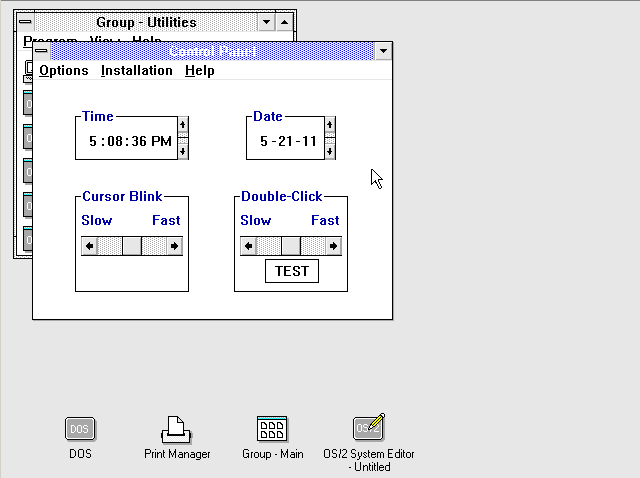 Oh sure there is a control panel, but it’s mostly rigged to date, time, and the incredibly convoluted process for adding a printer.  I’m just glad that my printer has been preserved to this point.
Oh sure there is a control panel, but it’s mostly rigged to date, time, and the incredibly convoluted process for adding a printer.  I’m just glad that my printer has been preserved to this point.
Since this is OS/2 1.2 there is some applications at this point I do have that will work. Â Namely Microsoft Excel 3.0 for OS/2. Â Installation is just like installing Excel 3 on Windows. Â 3 disks, and a reboot.
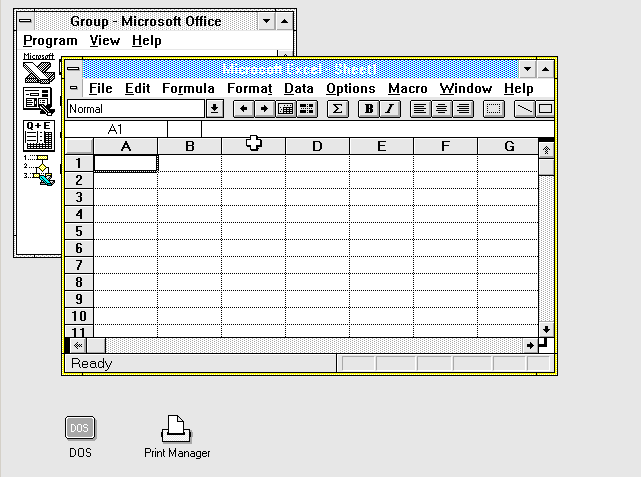 Since there was no divorce at this point Excel runs just fine.
Since there was no divorce at this point Excel runs just fine.
 And PMWord 1.1 (Microsoft Word 1.1 for OS/2). Â So far so good, right?
And PMWord 1.1 (Microsoft Word 1.1 for OS/2). Â So far so good, right?
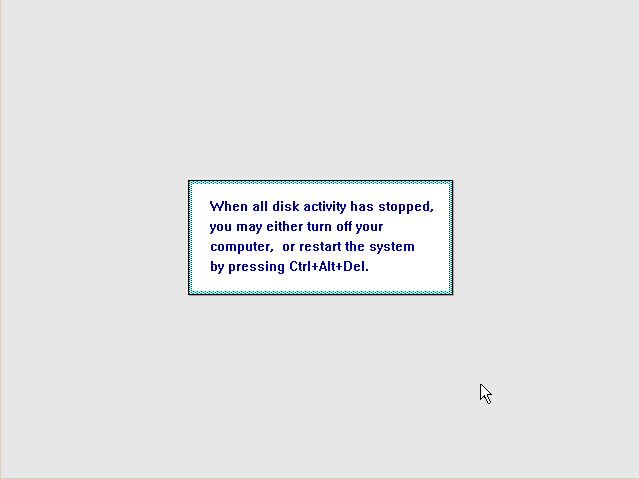 And it can shutdown!  So really what are my impressions of OS/2 so far?  It’s come a LONG way, it’s starting to feel like something workstation esque, but really it’s just so.. barren.  With the ‘standard’ version you don’t have all the accessories you did get with Windows.  I know they were largely ‘junk’ but hell even having the windows terminal with X-modem was still awesome for the time as you could actually kind of multitask. It would have been different for OS/2 but you’d never know it.  IBM & Microsoft really expected people to fall in love with the multitasking, and basically bear with the ultra minimalism of OS/2.  But Windows 3.0 changed everything.
And it can shutdown!  So really what are my impressions of OS/2 so far?  It’s come a LONG way, it’s starting to feel like something workstation esque, but really it’s just so.. barren.  With the ‘standard’ version you don’t have all the accessories you did get with Windows.  I know they were largely ‘junk’ but hell even having the windows terminal with X-modem was still awesome for the time as you could actually kind of multitask. It would have been different for OS/2 but you’d never know it.  IBM & Microsoft really expected people to fall in love with the multitasking, and basically bear with the ultra minimalism of OS/2.  But Windows 3.0 changed everything.
Anyways, Onward to OS/2 1.3!
Continuing from the previous post, let’s get started with Microsoft OS/2 1.1
I added a 500MB hard disk to VirtualBOX, booted up an OS/2 1.1 boot diskette I had created that allows me to fdisk/format and do basic backup/restores, esp since OS/2 1.0 cannot install on a large (lol) 500MB disk.
So with the restore done, I’m booting up the Microsoft OS/2 1.1c Nokia OEM release.
The dates for this release is 2/20/1989. Â I would have imagined that the original version of OS/2 1.1 shipped in 1988, as mentioned by the copyright. Apparently the Microsoft versions of OS/2 1.0 & 1.1 included support for the 386 method of switching from protected mode to real mode, while the IBM versions only included the 286 triple fault method. Â I’d imagine the Microsoft ones would include both, but the only way to verify is to install on a 286. Â Something that I simply do not have.
This style of the OS/2 installer will be with us for quite some time. Â it’s not until Warp did the look and feel start to change.
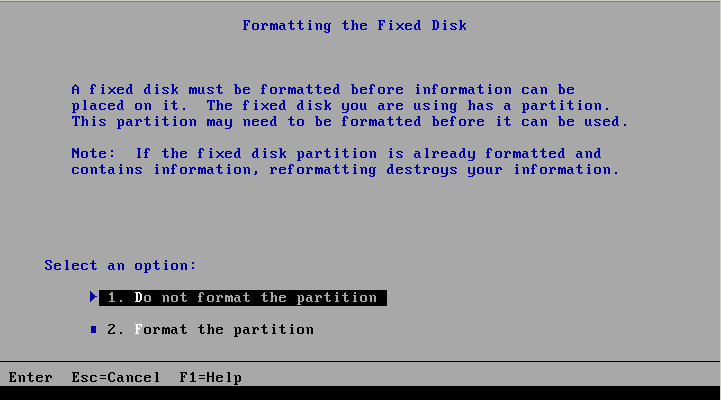 It’s a little worrisome that OS/2 is always looking for a way to format your drive. Â OS/2 1.1 only supports the FAT filesystem at this point, and formatting defeats the point of the upgrade.
It’s a little worrisome that OS/2 is always looking for a way to format your drive. Â OS/2 1.1 only supports the FAT filesystem at this point, and formatting defeats the point of the upgrade.
The setup program renames my config.sys , autoexec.bat and startup.cmd files. Â Obviously things are now different from OS/2 1.0
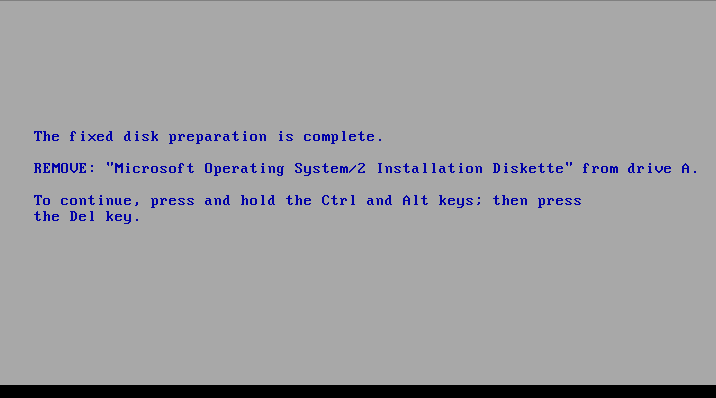 And at this point it’s just an install disk to prepare the disk, then we reboot off the hard disk to continue the install, in text mode.
And at this point it’s just an install disk to prepare the disk, then we reboot off the hard disk to continue the install, in text mode.
 We just feed some disks to the OS, then we get to select a mouse.
We just feed some disks to the OS, then we get to select a mouse.
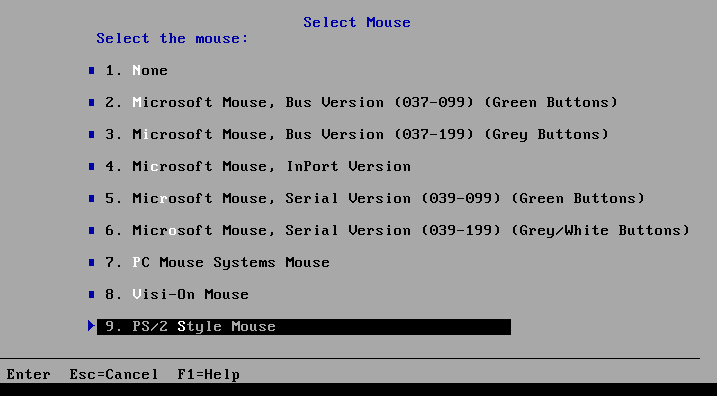 Thankfully the PS/2 option is in here! Very exciting stuff.
Thankfully the PS/2 option is in here! Very exciting stuff.
For some reason things like serial ports are optional, so after letting it load the serial driver, we are all set to go!
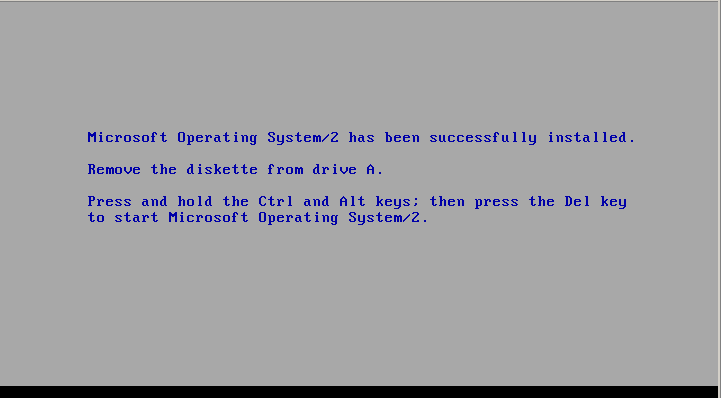 Ok, let’s experience some real OS/2 power!
Ok, let’s experience some real OS/2 power!
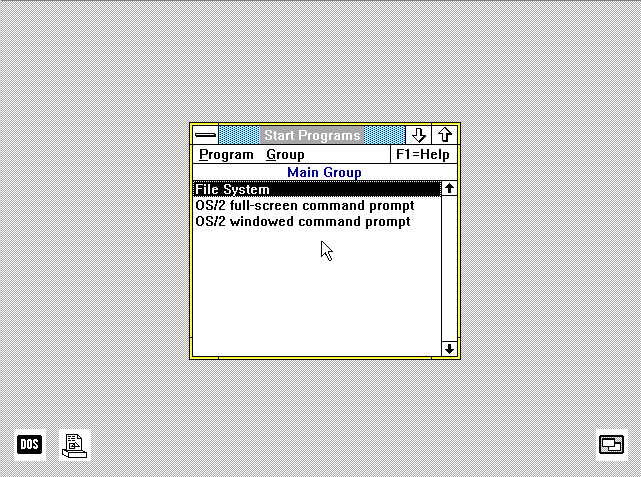 What is cool is that my printer choice has been preserved.
What is cool is that my printer choice has been preserved.
 And the C drive has been cleaned up… some. Â Although most of this stuff is backups of my OS/2 1.0 stuff, along with some portion of the OS/2 1.0 install in os2.000 .. I just deleted all of this crap.
And the C drive has been cleaned up… some. Â Although most of this stuff is backups of my OS/2 1.0 stuff, along with some portion of the OS/2 1.0 install in os2.000 .. I just deleted all of this crap.
Now to see OS/2 1.1 in action…
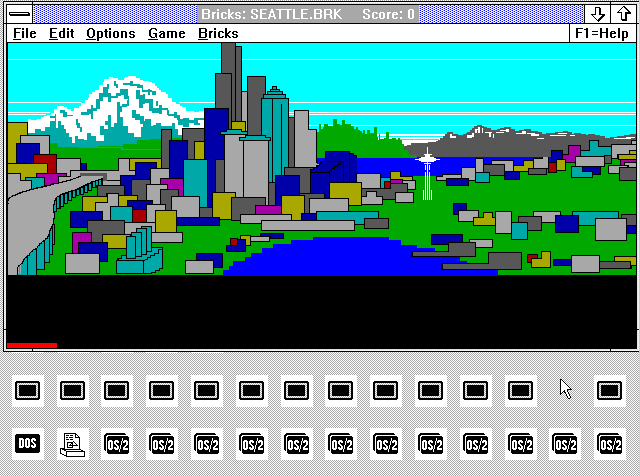 So again you are limited to 12 sessions in OS/2, along with the single DOS Box.  However notice that the windowed icons (the black ones) and the full screen are independent.  This was also another annoyance in OS/2, that you cannot switch an application from full to windowed at will, and some text mode stuff is compiled as full screen so launching it from a window will jump you fullscreen.  OS/2 also finally included a game, a breakout clone, with various neat pictures.  I like the Seattle one myself.
So again you are limited to 12 sessions in OS/2, along with the single DOS Box.  However notice that the windowed icons (the black ones) and the full screen are independent.  This was also another annoyance in OS/2, that you cannot switch an application from full to windowed at will, and some text mode stuff is compiled as full screen so launching it from a window will jump you fullscreen.  OS/2 also finally included a game, a breakout clone, with various neat pictures.  I like the Seattle one myself.
And a text editor! A nice one too. Â Also I don’t know if it’s VirtualBOX but the UI is VERY sluggish, the worst thing you can do is open a command window and have it scroll.
But all in all, OS/2 1.1 was certainly a step in the right direction, and really what people would start to expect in an OS. Â The GUI really is needed to get a feel for multitasking. Â It’s a shame that ‘paging’ the real mode box out to disk and going between multiple sessions could have been done…. But I imagine they tried it, and it failed badly. Â Or the paging got out of hand.. Hard to say.
As a slight detour I’ve also setup IBM OS/2 1.1 Extended Edition, which you can see my quick review here.
And for the few people who care, here is what 1.1 in Mono EGA mode looked like:
The other things that Microsoft OS/2 is really lacking is online documentation, and a way to shut down the OS from the desktop. It’s still control-alt-delete.
Onward to OS/2 1.2
On the heels of the upgrading Windows, I thought I’d do something similar with OS/2.
So to get things started, let’s start with OS/2 1.0
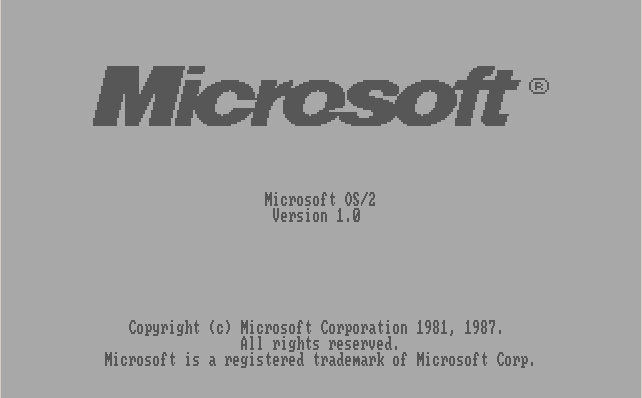 I’ve got to admit it, I really like the splash screen stuff. Â It’s a shame that basically it wouldn’t come back until Windows 95. Â This one does animate, but on VirtualBOX it is hard to see what it’s doing but I think it’s the logo coming together, like it did in early Windows.
I’ve got to admit it, I really like the splash screen stuff. Â It’s a shame that basically it wouldn’t come back until Windows 95. Â This one does animate, but on VirtualBOX it is hard to see what it’s doing but I think it’s the logo coming together, like it did in early Windows.
The installer is text based, as is the OS back then. Â To get this to run, I had to hexedit the keyboard driver (as discussed here) and change the hard disk driver from a non-working IBM version of OS/2 1.0 . Â None of the Microsoft ones seemed to work.
In 1987 this would be an awesome kickass machine. Â Now kids toys have better features. Â At any rate, back then FAT was limited to 32MB partitions. I just gave this thing a 32MB disk, as I didn’t feel the need to mess with it too much.
Talk about a weird installation process.
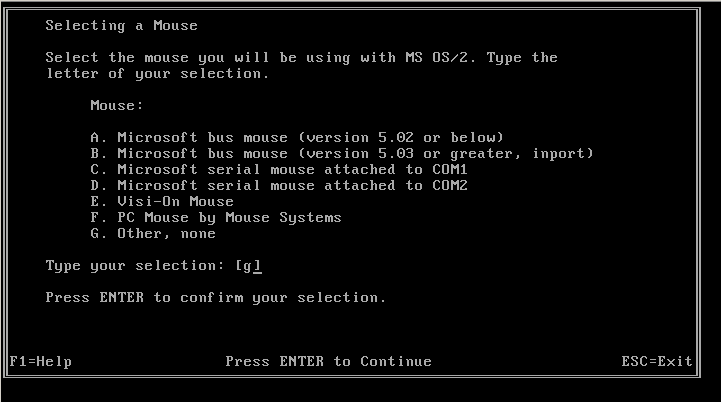 Notice the lack of PS/2 mice? Â This would go back and forth as one of many weird things that one or the other would not support. Â It’s very strange. Â But at the time of course, only PS/2 machines could have PS/2 mice. Â Not that it really matters in OS/2 1.0’s text only interface.
Notice the lack of PS/2 mice? Â This would go back and forth as one of many weird things that one or the other would not support. Â It’s very strange. Â But at the time of course, only PS/2 machines could have PS/2 mice. Â Not that it really matters in OS/2 1.0’s text only interface.
And the next time you feel like complaining about a lack of drivers for anything.. Look at this extensive list.
Anyways basically pick out what you are going to do , and away it goes copying the first floppy then it’s time to reboot.
I should also point out at this point the install for OS/2 is three (yes 3!) high density diskettes.
On reboot we continue the install..
And now we can eject the disks, and reboot. Â We get the nice splash screen only to be dumped to…
This. Now you can see why so many people were underwhelmed by OS/2. Â Now I know it’s a tough thing that Microsoft & IBM were at here, the basic underlying structure of OS/2 was working, IBM had been selling IBM AT’s since 1984 going on about some advanced OS, and the PS/2 line had just launched, with… MS-DOS. Â The need to spend 15+ thousand dollars on a fancy 286 to run MS-DOS just seemed totally insane. Â So they launched without the UI.
I’m thinking this must be a late version of 1.0 as my files are timestamped 12/15/1987. While not immediately obvious, this version can multitask like all the others. hitting control-escape brings up the Program Selector:
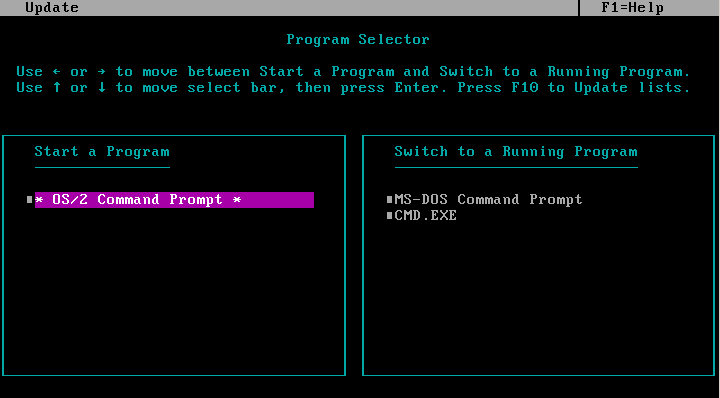 And tabbing around we can run a bunch more of the OS/2 command prompts, and select the single MS-DOS task that the 1.x versions of OS/2 are limited to.
And tabbing around we can run a bunch more of the OS/2 command prompts, and select the single MS-DOS task that the 1.x versions of OS/2 are limited to.
Shutting down OS/2 involved control-alt-delete.  Remember OS/2 was designed to be a single user workstation, not a multi-user time-sharing system like Unix.
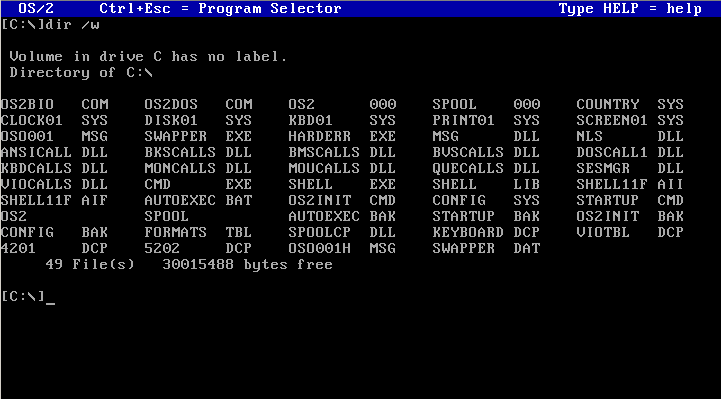 One thing I dislike immensely about OS/2 1.0 is that it dumps all the files into the root directory.  What a mess!  I mean look at this!  Ugh.
One thing I dislike immensely about OS/2 1.0 is that it dumps all the files into the root directory.  What a mess!  I mean look at this!  Ugh.
 Also it was interesting that you can run 12 OS/2 sessions, and the one MS-DOS session. Â Oh well it’s a heck of a lot more responsive the Windows trying to run this many sessions. Â Also for you GWBasic fans out there, you’ll be happy to know OS/2 includes GW Basic 3.20
Also it was interesting that you can run 12 OS/2 sessions, and the one MS-DOS session. Â Oh well it’s a heck of a lot more responsive the Windows trying to run this many sessions. Â Also for you GWBasic fans out there, you’ll be happy to know OS/2 includes GW Basic 3.20
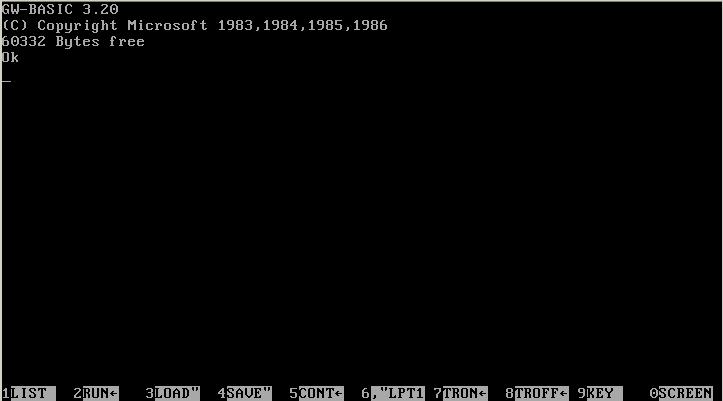 Oddly enough there are no text editors. Â I guess everyone is expected to be running wordstar under the ‘MS-DOS’ session box. Â And of course sure you can task switch but only ONE copy.. and no cut/paste…
Oddly enough there are no text editors. Â I guess everyone is expected to be running wordstar under the ‘MS-DOS’ session box. Â And of course sure you can task switch but only ONE copy.. and no cut/paste…
Ok, So now I’m going to backup this OS/2 1.0 session, restore it onto a larger disk (which OS/2 1.0 cannot boot from) but then I can ‘upgrade’ it to 1.1.
Onward to OS/2 1.1